

UNITED STATES
SECURITIES AND EXCHANGE COMMISSION
Washington, D.C. 20549
SCHEDULE 14A
Proxy Statement Pursuant to Section 14(a) of the Securities
Exchange Act of 1934 (Amendment No. )
 | Filed by the Registrant |  | Filed by a Party other than the Registrant |
| Check the appropriate box: | |
 | Preliminary Proxy Statement |
 | CONFIDENTIAL, FOR USE OF THE COMMISSION ONLY (AS PERMITTED BY RULE 14a-6(e)(2)) |
 | Definitive Proxy Statement |
 | Definitive Additional Materials |
 | Soliciting Material Pursuant to §240.14a-12 |


Brown-Forman Corporation
(Name of Registrant as Specified In Its Charter)
(Name of Person(s) Filing Proxy Statement, if other than the Registrant)
| Payment of Filing Fee (Check the appropriate box): | |
 | No fee required. |
 | Fee computed on table below per Exchange Act Rules 14a-6(i)(1) and 0-11. |
| (1) Title of each class of securities to which transaction applies: | |
| (2) Aggregate number of securities to which transaction applies: | |
| (3) Per unit price or other underlying value of transaction computed pursuant to Exchange Act Rule 0-11 (set forth the amount on which the filing fee is calculated and state how it was determined): | |
| (4) Proposed maximum aggregate value of transaction: | |
| (5) Total fee paid: | |
 | Fee paid previously with preliminary materials. |
 | Check box if any part of the fee is offset as provided by Exchange Act Rule 0-11(a)(2) and identify the filing for which the offsetting fee was paid previously. Identify the previous filing by registration statement number, or the Form or Schedule and the date of its filing. |
| (1) Amount Previously Paid: | |
| (2) Form, Schedule or Registration Statement No.: | |
| (3) Filing Party: | |
| (4) Date Filed: | |

2017 PROXYSTATEMENT
& NOTICE OF ANNUALMEETING OF STOCKHOLDERS

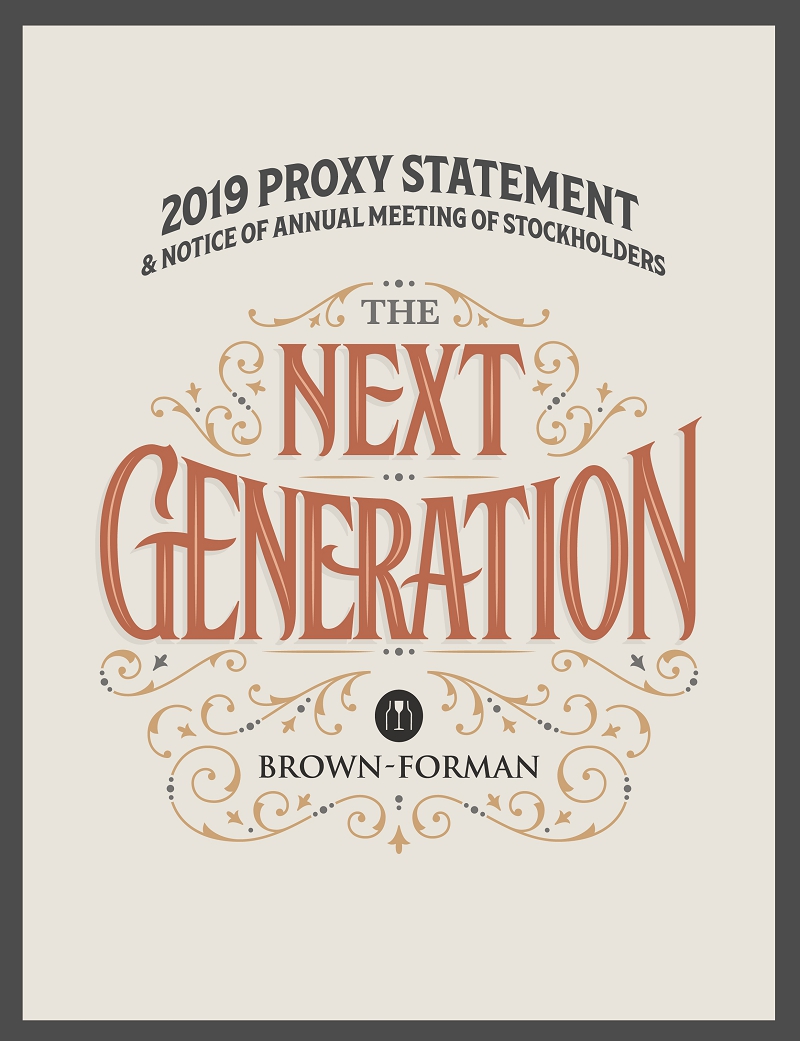





June 27, 201725, 2019
DEAR BROWN-FORMAN STOCKHOLDER:

It is our pleasure to invite you to attend Brown-Forman Corporation’s 20172019 Annual Meeting of Stockholders, which will be held at the Brown-Forman Conference Center in Louisville, Kentucky, onThursday, July 27, 201725, 2019, at 9:30 A.M. (Eastern Daylight Time). Please see the Notice of Annual Meeting on the next page for more information about this location and our admission procedures.
Your vote is important to us.We urge you toPlease complete and return your proxy card, or to vote by telephone or online as soon as possible, even if you plan to attend the Annual Meeting.
We hope to see you on July 27.25. On behalf of the Board of Directors, thank you for your continued support.
Very truly yours,

Paul C. Varga,
Chairman and Chief Executive Officer

 |  |
Geo. Garvin Brown IV, Chairman of the Board of Directors | Lawson E. Whiting, President and Chief Executive Officer |



NOTICE OF ANNUAL MEETING OF STOCKHOLDERS
| DATE: | Thursday, July |
| TIME: | 9:30 A.M.(Eastern Daylight Time) |
| LOCATION: | Brown-Forman Conference Center |
| 850 Dixie Highway | |
| Louisville, Kentucky 40210 |
We are holding this meeting for the following purposes:
| • | To elect the |
| • | To transact any other business that may properly come before the |
Class A stockholders of record at the close of business on June 19, 2017,17, 2019, are entitled to vote at the meeting, either in person or by proxy.
There are several ways to vote. You may complete, sign, and date the enclosed proxy card and return it in the enclosed envelope, or you may vote by telephone (1-800-652-8683)(1-800-690-6903) or online ((www.investorvote.com/BFB)www.proxyvote.com). Whatever method you choose, please vote in advance of the meeting to ensure that your shares will be voted as you direct. Instructions on telephone and online voting are on the proxy card enclosed with this Proxy Statement.
Louisville, Kentucky
June 27, 201725, 2019


By order of the Board of Directors
Matthew E. Hamel, Secretary
IMPORTANT NOTICE REGARDING AVAILABILITY OF PROXY MATERIALS FOR THE ANNUAL MEETING OF STOCKHOLDERS TO BE HELD ON JULY 25, 2019:
The Notice of Annual Meeting, Proxy Statement, and Annual & Corporate Responsibility Report to Stockholders, which includes our Annual Report on Form 10-K for fiscal 2019, are available atwww.brown-forman.com/investors/annual-report/.
ADMISSION PROCEDURES
We are committed to providing a safe, secure environment for our stockholders, directors, employees, and guests. To that end, please observe the following procedures if you plan to attend the Annual Meeting:Meeting.
| • | Before the meeting:Please register on or before July |
| • | When you arrive:Brown-Forman representatives will direct you to the |
| • | What to bring:Everyone attending the meeting should bring a photo ID. If your shares are registered in the name of a bank, broker, or other holder of record, please also bring documentation of your stock ownership (such as a brokerage statement) as of June |
If you do not register in advance, you may still be admitted if you present a photo ID along with your proxy card, brokerage statement, or other documentation of stock ownership.

IMPORTANTTable of Contents

2019 PROXY STATEMENT AND NOTICE REGARDING AVAILABILITY OF PROXY MATERIALS FOR THE ANNUAL MEETING OF STOCKHOLDERS TO BE HELD ON JULY 27, 2017:
The Notice of Annual Meeting, Proxy Statement, and Annual Report to Stockholders, which includes our Form 10-K for fiscal 2017, are available atwww.brown-forman.com/ investors/annual-report/.
BROWN-FORMAN1

|  |
In this section, we highlight certain information about matters discussed in this Proxy Statement. As it is only a summary, we encourage you to read the entire Proxy Statement before voting.
ANNUAL MEETING OF STOCKHOLDERS
| DATE:Thursday, July | Brown-Forman Conference Center | ||
| 850 Dixie Highway | |||
| TIME:9:30 A.M.(Eastern Daylight Time) | Louisville, Kentucky 40210 |
PROPOSALSPROPOSAL FOR STOCKHOLDER VOTING
| Proposal | Our Board’s voting recommendation | Where to find details | |||
| Election of |  | FOR all nominees | Pages 16–20 | ||
PERFORMANCE AND COMPENSATION HIGHLIGHTS
We believe our executive compensation program continues to attract, motivate, reward, and retain a talented and diverse team of executives. These individuals lead our efforts to be the best brand builder in the spirits industry, and enable us to deliver superior and sustainable value for our stockholders. The incentive payouts to our executives described in this Proxy Statement reflect our performance both during the most recent fiscal 2017.year and over time.
The following charts compare trends in Brown-Forman’sour performance with respect to total shareholder return (TSR), diluted earnings per share, and underlying operating income growth with trends in the compensation of our former Chief Executive Officer, Paul Varga.C. Varga, and current Chief Executive Officer, Lawson E. Whiting. These metrics reflect exceptional long-term value generated for our stockholders, and the charts show how our compensation strategy aligns with that performance.
OUR PERFORMANCE IN FISCAL 2017:2019:
 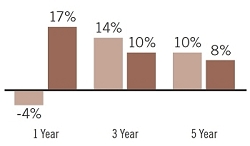 |  | 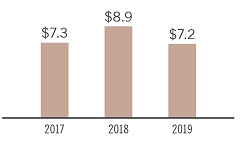 | ||
 | 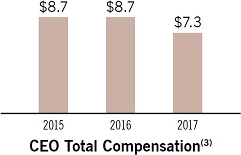 | |||
 TSR TSR  Earnings Per Share Earnings Per Share | Underlying Operating Income(1) | CEO Total Compensation(2) | ||
| (compound annual growth rate; Class B common stock) | (compound annual growth rate) | (in $ millions) |
| (1) | |
 | 2BROWN-FORMAN 2019 PROXY STATEMENT AND NOTICE OF ANNUAL MEETING OF STOCKHOLDERS
|
PROXY SUMMARY | OUR DIRECTOR NOMINEES TO THE BOARD
OUR DIRECTOR NOMINEES TO THE BOARD
Class A stockholders are being asked to vote on the election of the thirteenfourteen directors named below. More details about each director’s background, skills, and expertise can be found below under “Proposal 1: Election“Election of Directors” beginning on page 16. One new director, Kathleen M. Gutmann, joinedOn December 31, 2018, our former Chairman and Chief Executive Officer, Paul C. Varga, retired from his role as an employee and officer of Brown-Forman, but continues to serve as a member of the Board through the upcoming Annual Meeting to be held on July 25, 2019 (the Annual Meeting). In anticipation of Mr. Varga’s retirement, Lawson E. Whiting was appointed to the Board on May 24, 2017.November 15, 2018, and became Chief Executive Officer of Brown-Forman on January 1, 2019.
Board Nominees
| Committee Membership | ||||||||||||||
| Nominee Name & Occupation | Age | Director Since | Director Category | Audit | Comp | Corp Gov & Nom | Exec | |||||||
| Patrick Bousquet-Chavanne | ||||||||||||||
| Chief Executive Officer, Emaar Malls | 61 | 2005 | I | • | • | |||||||||
| Campbell P. Brown | ||||||||||||||
| Senior Vice President, President and Managing Director of Old Forester, Brown-Forman | 51 | 2016 | B, M | |||||||||||
| Geo. Garvin Brown IV | ||||||||||||||
| Chairman of the Board, Brown-Forman | 50 | 2006 | B | • | C | |||||||||
| Stuart R. Brown | ||||||||||||||
| Managing Partner, Typha Partners, LLC | 54 | 2015 | B | |||||||||||
| Bruce L. Byrnes | ||||||||||||||
| Retired Vice Chairman of the Board, The Procter & Gamble Company | 71 | 2010 | I | • | • | |||||||||
| John D. Cook | ||||||||||||||
| Director Emeritus of McKinsey & Company | 66 | 2008 | I | • | C | • | ||||||||
| Marshall B. Farrer | ||||||||||||||
| Senior Vice President, Managing Director of GTR and Developed APAC Region, Brown-Forman | 48 | 2016 | B, M | |||||||||||
| Laura L. Frazier | ||||||||||||||
| Owner and Chairman, Bittners LLC | 61 | 2016 | B | |||||||||||
| Kathleen M. Gutmann | ||||||||||||||
| Chief Sales and Solutions Officer, United Parcel Service, Inc. | 50 | 2017 | I | • | ||||||||||
| Augusta Brown Holland | ||||||||||||||
| Founding Partner, Haystack Partners LLC | 43 | 2015 | B | |||||||||||
| Michael J. Roney | ||||||||||||||
| Retired Chief Executive Officer, Bunzl plc | 65 | 2014 | I | C | ||||||||||
| Tracy L. Skeans | ||||||||||||||
| Chief Transformation and People Officer, Yum! Brands, Inc. | 46 | 2018 | I | • | ||||||||||
| Michael A. Todman | ||||||||||||||
| Retired Vice Chairman, Whirlpool Corporation | 61 | 2014 | I | C | ||||||||||
| Lawson E. Whiting | ||||||||||||||
| President and Chief Executive Officer, Brown-Forman | 51 | 2018 | M | • | ||||||||||
B=Brown Family Director M=Management Director I=Independent Director C=Chair
“In building our brands and creating new opportunities, we are writing the next chapter in our story of innovation, perseverance, and success.”•=Committee Member
FISCAL 2019
Paul Varga, Chairman and CEO
22 RETURN ON | $310MM TOTAL DIVIDENDS | $200MM SHARE REPURCHASES | “Our prospects for delivering sustained growth remain bright as we develop our premium spirits portfolio around the world, led by Jack Daniel’s and Woodford Reserve.” Lawson E. Whiting, President and Chief Executive Officer | |||
(1) | ||||||
| Return on Invested Capital is not derived in accordance with GAAP. |
2019 PROXY STATEMENT AND NOTICE OF ANNUAL MEETING OF STOCKHOLDERSBROWN-FORMAN3 |  |


ABOUT YOUR PROXY MATERIALS
Our Board of Directors (the Board) is soliciting proxies for our upcoming Annual Meeting of Stockholders to be held on July 27, 2017 (the Annual Meeting).Stockholders. This means that you can vote “by proxy” at the Annual Meeting —that— that is, you can instruct us how you would like your shares to be voted at the meeting whether or noteven if you cannot personally attend.
We are providing this Proxy Statement and accompanying materials to help you make an informed decision on the matters to be considered at the Annual Meeting. We will begin mailing this Proxy Statement and accompanying materials, and also make them available online, on or about June 27, 2017,25, 2019, to holders of record of our Class A and Class B common stock at the close of business on June 19, 2017,17, 2019, which is the “record date” for the Annual Meeting.
This Proxy Statement and our Annual & Corporate Responsibility Report, to Stockholders, which includes our Form 10-K for fiscal 2017,2019, are available atwww.brown-forman.com/investors/annual-report/.You may request additional printed copies at any time using the contact information below.
Please let us know as soon as possible how you would like your shares voted. To do this, you may complete, sign, date, and return the enclosed proxy card or voting instruction card, or you may instruct us by telephone or online. See “Voting”“How to Vote” below for details.
Contact Information
For information about your stock ownership or other stockholder services, please contact Linda Gering,Steve Cassin, our Stockholder ServicesInvestor Relations Manager, by telephone at (502) 774-7690,774-7658, by e-mail at Linda_Gering@b-f.com,Steve_Cassin@b-f.com, or by mail at Brown-Forman Corporation, 850 Dixie Highway, Louisville, Kentucky 40210.
Reducing Duplicate Mailings
The Securities and Exchange Commission (SEC) permits us to deliver a single Proxy Statement and Annual & Corporate Responsibility Report to stockholders who share the same address and last name, unlessname. Unless we receive contrary instructions from any stockholder in the household. Evenhousehold, even if your household receives only one Proxy Statement and Annual & Corporate Responsibility Report, each stockholder will receive an individual proxy card. We participate inimplemented this “householding” process to reduce our printing costs and postage fees, and to better facilitate voting.reduce the environmental impact of our Annual Meeting. If you would like to enroll in “householding,”householding, or if your household is already enrolled but you prefer to opt out of “householding”householding for next year, please inform us using the contact information above and we will promptly fulfill your request.
ATTENDING THE ANNUAL MEETING
Although only Class A stockholders may vote at the Annual Meeting, Class A and Class B stockholders who owned their shares as of June 19, 2017,the record date are welcome to attend.
If you plan to attend, please register by July 25, 2017,23, 2019, online at asm.b-f.com or by contacting Linda GeringSteve Cassin using the contact information above. Please bring a photo ID and, if your shares are registered in the name of a bank, broker, or other holder of record, documentation of your stock ownership as of the record date.Please see “Admission Procedures” outlined in the Notice of Annual Meeting of Stockholders for full details.
VOTING
Who May Vote
If you held shares of Class A common stock at the close of business on the record date, (June 19, 2017), you or(or your legal proxies,proxies) may vote at the Annual Meeting on all three proposals.Meeting. At the close of business on the record date, there were 169,062,117169,038,689 shares of Class A common stock outstanding and entitled to vote at the Annual Meeting. At the close of business on the record date, there were 215,189,294308,489,725 shares of Class B common stock outstanding, however thoseoutstanding. Class B shares are not entitled to vote.
If you purchased Class A common stock after the record date, you may vote those shares only if you receive a proxy to do so from the person who held the shares on the record date. Each share of Class A common stock is entitled to one vote. If you receive more than one proxy card or voting instruction card, you should complete, sign, date, and return each one (or follow the telephone or online voting instructions) because the cards representeach card represents different shares.
 | 4BROWN-FORMAN 2019 PROXY STATEMENT AND NOTICE OF ANNUAL MEETING OF STOCKHOLDERS |
ANNUAL MEETING INFORMATION •| VOTING
How to Vote
Stockholders of record.If your shares are registered directly in your name with our stock transfer agent, Computershare, you are considered the “stockholder of record” of those shares. If you are a stockholder of record of Class A shares,common stock, you can give a proxy to be voted at the meeting:Annual Meeting:
• over the telephone by calling a toll-free number (1-800-652-8683);
• online(www.investorvote.com/BFB); or
• by completing, signing, and mailing the enclosed proxy card in the envelope provided.
 | over the telephone by calling this toll-free number (1-800-690-6903); |  | online (www.proxyvote.com); or |  | by completing, signing, dating, and mailing the enclosed proxy card in the envelope provided. |
Even if you plan to attend the meeting,Annual Meeting, we encourage you to submit a proxy in advance. WeIf you are voting by telephone or online, we must receive your proxy by 1:00 a.m.11:59 P.M., Eastern Daylight Time, on Thursday,Wednesday, July 27, 2017,24, 2019, to ensure your vote is recorded. You may override a proxy or change your voting instructions by following the applicable procedure outlined below in “Changing Your Vote.”
The telephone and online voting procedures have been set up for your convenience and are designed to authenticate your identity, enable you to give voting instructions, and confirm that those instructions are recorded properly. If you are a stockholder of record and wish to vote by telephone or online, please refer to the instructions on the enclosed proxy card.
Your proxy will authorize the individuals named on the proxy card to vote your shares in accordance with your instructions. These individuals also will also have the obligation and authority to vote your shares as they see fit on any other matter properly presented for a vote at the Annual Meeting. If for any reason a director nominee is not available to serve, the individuals named as proxy holders may vote your shares at the Annual Meeting for another nominee. The proxy holders for this year’s Annual Meeting are Geo. Garvin Brown IV, Paul C. Varga,Lawson E. Whiting, and Matthew E. Hamel.
If you are a stockholder of record and you sign and return your proxy card (or give your proxy by telephone or online) without specifying how you want your shares to be voted, our proxy holders will vote your shares “FOR” the election of each of the nominees to the Board (Proposal 1), “FOR” the advisory resolution to approve our executive compensation (Proposal 2), and for “EVERY THREE YEARS” as the frequency of future advisory votes on executive compensation (Proposal 3). With respect to any other matter that properly comes before the Annual Meeting, the proxy holders will vote your shares as recommended by the Board or, if no recommendation is given, using their own discretion.
| If you are a stockholder of record and you sign and return your proxy card (or give your proxy by telephone or online) without specifying how you want your shares to be voted, our proxy holders will vote your shares “FOR” the election of each of the nominees to the Board. With respect to any other matter that properly comes before the Annual Meeting, the proxy holders will vote your shares as recommended by the Board or, if no recommendation is given, using their own discretion. |
“Street name” stockholders.If your shares are held in a stock brokerage account or by a bank (known as holding shares in“street namename””), you have the right to instruct your broker or bank how to vote your shares, and the broker or bank is required to vote in accordance with your instructions. To provide those instructions by mail, please complete, sign, date, and return your voting instruction card in the accompanying postage-paid envelope provided by your broker or bank.envelope. Alternatively, if the broker or bank that holds your shares offers online or telephone voting, you will receive information from your broker or bank about how to submit your voting instructions by those methods. You may vote in person at the meeting,Annual Meeting, but only if you obtain a “legal proxy” from the broker or bank that holds your shares.
If you are a street name stockholder and you do not instruct your broker how to vote, your broker is not permitted to vote your shares on any of the proposals we will address at the Annual Meeting. This is known as a “broker non-vote.”
| If you are a street name stockholder and you do not instruct your broker how to vote, your broker is not permitted to vote your shares on the election of directors. Under the rules of various securities exchanges, brokers that hold your shares may generally use their discretion to vote on “routine” matters but not on “non-routine” matters. If your broker does not receive voting instructions from you on how to vote your shares on a “non-routine” matter, your shares will not be represented on such matters. (This is known as a “broker non-vote.”) The election of directors is considered a “non-routine” matter; therefore, your broker is not permitted to vote your shares on the election of directors unless you provide voting instructions. |
Changing Your Vote
If you are astockholder of record, you may change your vote by submitting another proxy by telephone or online, by mailing another properly signed proxy card bearing a later date than your original one, or by attending the Annual Meeting and casting your vote in person. You also may revoke a proxy that you previously provided by delivering timely written notice of revocation to our Secretary, Matthew E. Hamel, at Brown-Forman Corporation, 850 Dixie Highway, Louisville, Kentucky 40210, or at Secretary@b-f.com.
If you hold your shares instreet nameand you wish to change or revoke your voting instructions, please refer to the materials your broker or bank provided to you for instructions.
2019 PROXY STATEMENT AND NOTICE OF ANNUAL MEETING OF STOCKHOLDERS BROWN-FORMAN5 |  |
ANNUAL MEETING INFORMATION • | ANNOUNCEMENT OF VOTING RESULTS
Quorum Requirements
Business can be conducted at the Annual Meeting only if a quorum consisting of a majority of the outstanding shares of Class A common stock is present in person or represented by proxy. Abstentions and broker non-votes, if any, will be counted as present for purposes of establishing a quorum.
Votes Needed For Approval
| Proposal | Vote required to pass | Effect of abstentions and broker non-votes | ||
| Election of directors | Nominees who receive a majority of the Class A votes cast (thenumber of shares voted “for” the nominee exceeds the number | No effect. | ||
| Any other matter | ||||
| Approval requires an affirmative vote of the majority of the Class Ashares present (in person or represented by proxy) and entitled to vote. | Abstentions are equivalent to votesagainstthe proposal.
Broker non-votes will have no effect. | |||
|
Dividend Reinvestment and Employee Stock Purchase Plan Shares
Shares of Class A common stock held in Brown-Forman’s dividend reinvestment and employee stock purchase plans are included in your holdings and reflected on your proxy card. These shares will be voted as you direct.
ANNOUNCEMENT OF VOTING RESULTS
We intend to announce the preliminary voting results at the Annual Meeting and to issue a press release announcing the final voting results later that day. In addition, we will report the final voting results by filing a Form 8-K with the SEC within four business days following the Annual Meeting.
PROXY SOLICITATION EXPENSES
Brown-Forman bears the cost of soliciting proxies. Beginning on June 27, 2017,25, 2019, which is the mailing date for these proxy materials, our directors, officers, and other employees may solicit proxies in person or by regular or electronic mail, email, phone, fax, or online. These individuals will not receive additional compensation for soliciting proxies. We will reimburse banks, brokers, nominees, and other fiduciaries for their reasonable charges and expenses incurred in forwarding our proxy materials to the beneficial owners of our stock held in street name. In addition, we have retained Proxy Express, Inc. to assist with the distribution of proxy materials for a fee of approximately $15,000, plus expenses.
 | 6BROWN-FORMAN 2019 PROXY STATEMENT AND NOTICE OF ANNUAL MEETING OF STOCKHOLDERS |
|
|
|  |
CORPORATE GOVERNANCE •BOARD COMPOSITION

Our Board is the policy-making body that is ultimately responsible for Brown-Forman’s business success and ethical climate. The Board oversees the performance of our senior management team, which is responsible for leading and operating Brown-Forman’s business. The Board’s primary responsibilities include retention, evaluation, and succession planning for the Chief Executive Officer and the Chairman of the Board, as well as oversight of our corporate strategy, financial condition, executive compensation policies and practices, and enterprise risk management. The Board may retain independent advisors to help it perform its duties.
BROWN-FORMAN IS A “CONTROLLED COMPANY.”
As a publicly traded, family-controlled company, Brown-Forman enjoys a rare governance opportunity in that members of our controlling stockholder family, the Brown family, participate directly on our Board. We believe this governance structure gives us a distinct competitive advantage because Brown family members bring a long-term ownership perspective to our Board. This advantage is sustained by a careful balancing of the roles of our Board, management, and our stockholders — including the Brown family.
In evaluating candidates for Board membership, the Corporate Governance and Nominating Committee seeks directors who will represent the long-term best interests of all stockholders. As articulated in our Corporate Governance Guidelines, all Brown-Forman directors should possess the highest personal and professional ethics, integrity, and values. The Board believes the best directors have the following additional qualities: good judgment, candor, civility, business courage, experience with businesses and other organizations of comparable character and comparable or larger size, and a lack of conflicts of interest. We also believe that a significant number of our directors should be independent.
The Corporate Governance and Nominating Committee and the Board consider diversity in evaluating candidates for Board membership, though neither has adopted a formal policy to that effect. The Board’s goal is to maintain a well-balanced composition that combines a variety of experiences, backgrounds, skills, and perspectives to enable the Board, as a whole, to guide Brown-Forman effectively in the pursuit of our strategic objectives. In evaluating potential Board candidates, the Corporate Governance and Nominating Committee considers an individual’s independence; business, professional, or public service experience; relevant industry knowledge, experience, and relationships; business judgment; financial expertise; international experience; leadership skills; age, gender, race, and other personal characteristics; time availability; and familial relation to our controlling family stockholders.
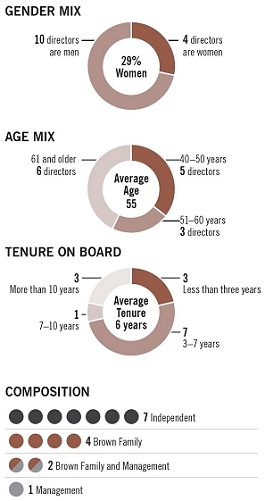
2019 PROXY STATEMENT AND NOTICE OF ANNUAL MEETING OF STOCKHOLDERSBROWN-FORMAN 7
CORPORATE GOVERNANCE | BOARD COMPOSITION
The Corporate Governance and Nominating Committee occasionally engages independent search firms to assist in identifying potential Board candidates. The Board has not adopted a formal policy regarding stockholder-nominated director candidates because the Corporate Governance and Nominating Committee believes the process it follows to identify and select Board members has been appropriate and effective. Any candidates submitted by stockholders will be evaluated in the same manner as all other director candidates.
How Our Controlled-Company Status Affects Our Board
Our Board has determined that Brown-Forman is a “controlled company” under New York Stock Exchange (NYSE) rules because more than 50% of our Class A voting stock is held by members of the Brown family.
As a controlled company, we are exempt from NYSE listing standards that require boards to have a majority of independent directors, a fully independent nominating/corporate governance committee, and a fully independent compensation committee. As a matter of good corporate governance, the Board has voluntarily chosen to have a Compensation Committee that is composed entirely of directors who meet the NYSE’s heightened independence standards for compensation committee members. Our Board does not have a majority of independent directors or a fully independent nominating/corporate governance committee. We are not exempt from, and comply in full with, requirements respecting the independence and qualifications of our Audit Committee members.
Our Independent Directors
We recognize the value of having independent directors. Under NYSE listing rules, a director qualifies as “independent” if the board of directors affirmatively determines the director has no material relationship with the company. Material relationships can include commercial, industrial, banking, consulting, legal, accounting, charitable, and familial relationships. While the focus is on independence from management, our Board considers all relevant facts and circumstances in making an independence determination. Our Board recognizes the value of having independent directors, and has determined that sixthe following seven directors are independent under NYSE standards: Patrick Bousquet-Chavanne, Bruce L. Byrnes, John D. Cook, Kathleen M. Gutmann, Michael J. Roney, Tracy L. Skeans, and Michael A. Todman.
The Board has determined that Geo. Garvin Brown IV, Campbell P. Brown, Marshall B. Farrer, and Paul C. VargaLawson E. Whiting are not independent because they are or recently have been, members of Brown-Forman management. The Board elected not to make a determination with respect to the independence of Geo. Garvin Brown IV, Stuart R. Brown, Laura L. Frazier, and Augusta Brown Holland.
Our Brown Family Directors
We believe it is strategically important for Brown family members to be actively engaged in the oversight of Brown-Forman. Through participation on the Board, the Brown family’s long-term perspective is brought to bear, in some measure, upon each and every matter the Board considers. Brown family directors also serve as an effective link between the Board and the controlling family stockholders.
In addition, Board service allows the Brown family to actively oversee its investment in the Company.company. Currently, the Brown family directors are:are Campbell P. Brown, Geo. Garvin Brown IV, Stuart R. Brown, Marshall B. Farrer, Laura L. Frazier, and Augusta Brown Holland.
 | 8BROWN-FORMAN 2019 PROXY STATEMENT AND NOTICE OF ANNUAL MEETING OF STOCKHOLDERS |
CORPORATE GOVERNANCE •| BOARD COMPOSITION
Our Management Directors
We also believe it is important, from a corporate governance standpoint, for management to be represented on the Board. Currently, Campbell P. Brown, Marshall B. Farrer, and Paul C. VargaLawson E. Whiting serve in dual roles as Board members and Brown-Forman executives.
BROWN-FORMAN BOARD OF DIRECTORS
PATRICK BOUSQUET-CHAVANNE |
CAMPBELL P. BROWN |
GEO. GARVIN BROWN IV | ||||||||
 | Chief Executive Officer, Emaar Malls |  | ||||||||
 |  | Senior Vice President, President and Managing Director of Old Forester, Brown-Forman Corporation |   | Chairman of the Board, Brown-Forman Corporation | ||||||
STUART R. BROWN |
BRUCE L. BYRNES | |||||||||
JOHN D. COOK | ||||||||||
  | Managing Partner, Typha Partners, LLC |   | Retired Vice Chairman of the Board, The Procter & Gamble Company |   | ||||||
MARSHALL B. FARRER |
LAURA L. FRAZIER |
KATHLEEN M. GUTMANN | ||||||||
 | Senior Vice President, Managing Director of GTR and Developed APAC Region, Brown-Forman Corporation |  | ||||||||
 | ||||||||||
 |
AUGUSTA BROWN HOLLAND | 
MICHAEL J. RONEY |
TRACY L. SKEANS | |||||||
 | Founding Partner, Haystack Partners LLC |   | Retired Chief Executive Officer, Bunzl plc |  | Chief | |||||
MICHAEL A. TODMAN |
LAWSON E. WHITING |  INDEPENDENT BROWN FAMILY MANAGEMENT BROWN FAMILY & MANAGEMENT | ||||||||
 |  |   | Retired Vice Chairman, Whirlpool Corporation | |||||||
 | ||||||||||
| ||||||
 | ||||||
Recent Changes to Our Board As previously disclosed, our President and Chief Executive Officer, Lawson E. Whiting, joined the Board on November 15, 2018. Paul C. Varga, our former Chairman and Chief Executive Officer, will retire from the Board as of the Annual Meeting. 2019 PROXY STATEMENT AND NOTICE OF ANNUAL MEETING OF STOCKHOLDERS |  |
CORPORATE GOVERNANCE •| LEADERSHIP STRUCTURE
| BOARD LEADERSHIP STRUCTURE | ||
| Geo. Garvin Brown IV, a Brown family member, has served asChairman ofthe Boardsince 2007. | Lawson E. Whiting has served asPresident and Chief Executive Officer since 2019. | John D. Cook has served asLead Independent Directorsince 2012. |
Chairman of the Board
Our Board believes that the determination of whether to separate or combine the roles of Chairman of the Board and Chief Executive Officer should depend largely upon the identity of the Chief Executive Officer and the composition of the Board at the time. For this reason, itthe Board does not have a policy on separation of these roles, but rather evaluates the situation on a case-by-case basis. Currently,Although these roles arehave been separate althoughsince 2007, they have been combined in the past. Geo. Garvin Brown IV, a Brown family member, serves as Chairman of the Board.
Company Chairman and CEO
Paul C. Varga serves as the Chairman and Chief Executive Officer of Brown-Forman. Mr. Varga is our highest ranking executive officer and is responsible for Brown-Forman’s strategy, operations, and performance.
Lead Independent Director
When a non-independent director who has not been determined to be independent holds the office of Chairman of the Board or Presiding Chairman of the Board, as is currently the case, the Board may select one independent director (after considering the recommendation of the Corporate Governance and Nominating Committee) to serve as Lead Independent Director. The Lead Independent Director, if any, will beis elected annually. John D. Cook has served in this role since 2012.
As Lead Independent Director, Mr. Cook’s responsibilities are to:include calling meetings of the independent directors and non-management directors, when necessary or advisable, and setting the agenda for and chairing those meetings. Other responsibilities appear in our Corporate Governance Guidelines at our website (www.brown-forman.com/about/ corporate-governance/guidelines).
Mr. Cook chaired one executive session of non-management directors in fiscal 2017. Also, because our non-management director group includes directors who are not “independent” under NYSE listing standards, Mr. Cook2019 and called and presided over one executive session in fiscal 20172019 that was attended solely by our independent directors.
President and Chief Executive Officer
As the President and Chief Executive Officer of Brown-Forman, Mr. Whiting is our highest ranking executive officer and is responsible for Brown-Forman’s strategy, operations, and performance. Mr. Whiting also serves as a management member of our Board.
Why the Board Chose this Leadership Structure
The Board has determined that this leadership structure currently serves the best interests of Brown-Forman and all of its stockholders. Having a Brown family member serve as Chairman of the Board promotes the Brown family’s active oversight of, and engagement and participation in, the Companycompany and its business and reflects the fact that Brown-Forman is controlled by the Brown family. In addition, because Mr. Brown handles the responsibilities associated with the position of Chairman of the Board, Mr. VargaWhiting can concentrate on strategy and operations, while the Board still has access to his comprehensive knowledge of the Company’sBrown-Forman’s business. The Lead Independent Director position provides leadership to, and fosters coordination among, our independent directors, enabling them to fulfill their role of bringing outside perspectives to the Board.
 | 10BROWN-FORMAN 2019 PROXY STATEMENT AND NOTICE OF ANNUAL MEETING OF STOCKHOLDERS |
CORPORATE GOVERNANCE •| BOARD GUIDELINES AND PROCEDURES
BOARD GUIDELINES AND PROCEDURES
Corporate Governance Guidelines
The Board believes transparency is a hallmark of good corporate governance. To that end, the Board has adopted Corporate Governance Guidelines that provide a framework for the Board to exercise its duties. Among other things, these guidelines contain policies and requirements regarding:regarding director qualifications; director responsibilities, including the Lead Independent Director’s role; meetings and attendance; committee composition and responsibilities; director compensation; and director access to management and independent advisors. The Corporate Governance Guidelines are published on our website atwww.brown-forman.com/about/corporate-governance/guidelines/..
Board and Committee Self-Assessment
The Corporate Governance Guidelines require the Board to conduct an annual self-assessment. Each Board committee (except the Executive Committee) also annually assesses how it performed during the preceding twelve-month period. These assessment procedures vary, from requiring members to complete questionnaires that call for both quantitative responses and free-ranging comments, to having an independent third party interview each member and then synthesize themes that emerge. This past fiscal year, our Chairman of the Board engaged in a 360 degree feedback process facilitated by an outside consultant. The Chairman of the Board, the Chief Executive Officer, and the Lead Independent Director consult at least annually regarding individual director performance.
Director Service on Other Public Company Boards
The Board recognizes that its members benefit from service on the boards of other companies. The Board encourages that service, with the understanding that our directors must have adequate time to devote to their work for Brown-Forman. The Corporate Governance Guidelines provide that any director who serves full-time as an officer or employee of Brown-Forman or any other entity should not serve on more than two public company boards in addition to the Brown-Forman Board, which includes the board of any public company at which a director is employed. Directors who are not employed full-time may serve on up to three public company boards in addition to the Brown-Forman Board. Directors must inform the Chairman, the Lead Independent Director, the Chair or Secretary of the Corporate Governance and Nominating Committee, or the Secretary of the Board as soon as practicable that they will be, or have been, elected to serve on an additional public company board.
The Board recognizes that service on the boards of nonprofit entities can be important and time consuming as well, and encourages directors to engage in such service as long as they continue to have the time necessary to devote to their work for Brown-Forman.
Director Service
The Board is authorized to fix the size of the Board at a number between three and seventeen members. Directors are elected each year at the Annual Meeting by a majority of the votes cast by our Class A stockholders. Once elected, a director holds office until the next Annual Meeting or until a successor is elected and qualified, unless the director first resigns, retires, or is removed. Directors areThe Board does not subject tohave term limits, but a directordirectors generally may not stand for re-election to the Board after reaching the age of 71. In exceptional circumstances, the Board may ask a director to remain on the Board until a given dateafter age 71 if the director’s continued service would significantly benefit Brown-Forman. Service of a director beyond the age of 71 requires a recommendation by the Corporate Governance and Nominating Committee and the approval of two-thirds of the Board (not including the director under consideration). The Board has determined that the continued service of Bruce L. Byrnes as director would be of significant value to Brown-Forman and has requested that Mr. Byrnes stand for election at the Annual Meeting for an additional term. Mr. Byrnes has agreed to do so.
Board Meetings
The Board held six regular meetings and no special meetings during fiscal 2017.2019. Absent an appropriate reason, all directors are expected to attend the Annual Meeting, all Board meetings, and all meetings of each committee on which they serve. All directors attended 90%75% or more of the aggregate meetings of the Board and committees on which they served during fiscal 2017.2019. All directors then serving attended the 20162018 Annual Meeting of Stockholders.Meeting.
2019 PROXY STATEMENT AND NOTICE OF ANNUAL MEETING OF STOCKHOLDERSBROWN-FORMAN 11
CORPORATE GOVERNANCE| BOARD GUIDELINES AND PROCEDURES
Board Committees
Our Board has four standing committees: Audit Committee, Compensation Committee, Corporate Governance and Nominating Committee, and Executive Committee. Each Board committee operates under a written charter that is posted on our website atwww.brown-forman.com/about/corporate-governance/committee-composition/.
| AUDIT COMMITTEE |
MET 9 TIMES IN FISCAL 2019
Committee Members:
| • | Michael A. Todman (Chair) | ||
| • | Bruce L. Byrnes | ||
| • | Kathleen M. Gutmann | ||
| • | |||
The Board has delegated to the Audit Committee responsibility for overseeing Brown-Forman’s financial statements; audit process; system of internal accounting and financial controls; policies and processes for assessment and management of enterprise risks, including cyber security risk; compliance with legal and regulatory requirements; and internal audit function. In addition, the Audit Committee is solely responsible for hiring the independent auditor and oversees the independent auditor’s qualifications, independence, and performance. The Audit Committee’s responsibilities include preparing the Audit Committee Report that appears in this Proxy Statement on page 55.
Audit Committee members must satisfy director independence standards prescribed by the NYSE and mandated by the Sarbanes-Oxley Act. Each member of our Audit Committee satisfies all of these heightened independence standards. The Board has determined that each member of our Audit Committee is also “financially literate” within the meaning of the NYSE rules, and that Mr. Todman is an “audit committee financial expert” under SEC rules.
| COMPENSATION COMMITTEE |
MET 5 TIMES IN FISCAL 2019
Committee Members:
|  |
| • | |
| • | John D. Cook |
The Compensation Committee’s responsibilities include determining the compensation of the Chief Executive Officer; recommending market-competitive compensation for the Board; approving incentive compensation plan design and changes thereto for the Chief Executive Officer and other senior executive officers; assisting the Board in its oversight of risk related to compensation policies and practices; overseeing the preparation of the Compensation Discussion and Analysis section of this Proxy Statement; preparing the Compensation Committee Report that appears in this Proxy Statement on page 39; and leading the evaluation of the performance of the Chief Executive Officer.
The Compensation Committee has retained Frederic W. Cook & Co., Inc. (FWC) to provide independent advice on executive and director compensation matters. For additional information on the services provided by FWC, as well as the Compensation Committee’s processes and procedures for considering and determining executive compensation, please see the Compensation Discussion and Analysis, which begins on page 24.
Each member of the Compensation Committee qualifies as an independent director under NYSE listing standards (including the heightened independence standards for compensation committee members of non-controlled companies), as a “non-employee director” under SEC rules, and as an “outside director” under regulations adopted pursuant to Section 162(m) of the Internal Revenue Code. The Board specifically considered factors relevant to the ability of these directors to be independent from management in connection with Compensation Committee service.
12BROWN-FORMAN2019 PROXY STATEMENT AND NOTICE OF ANNUAL MEETING OF STOCKHOLDERS
CORPORATE GOVERNANCE •| BOARD GUIDELINES AND PROCEDURES
MET 6 TIMES IN FISCAL 2019
Committee Members:
| • | |||
| • | Patrick Bousquet-Chavanne | ||
| • | Geo. Garvin Brown IV | ||
| • | Bruce L. Byrnes | ||
The Corporate Governance and Nominating Committee’s responsibilities include helping the Board identify, recruit, and recommend appropriate candidates to serve as directors; reviewing periodically our corporate governance principles in light of developments in corporate governance and best practices, taking into account our controlled-company status; coordinating and overseeing Chief Executive Officer succession planning; and assisting the Board with its annual self-assessment. All of the Corporate Governance and Nominating Committee members are independent under NYSE listing standards, except Geo. Garvin Brown IV.
| EXECUTIVE COMMITTEE |
DID NOT MEET IN FISCAL 2019
Committee Members:
| • | Geo. Garvin Brown IV (Chair) | ||
| • | John D. Cook | ||
| • | Paul C. Varga (until May 2019) | ||
 |
|
| Lawson E. Whiting (since November 2018) |
The Executive Committee consists of the Chief Executive Officer, the Chairman of the Board (if separate from the Chief Executive Officer), and one or more other directors as determined by the Board from time to time. In fiscal 2019, the Lead Independent Director served on the Executive Committee, and both Mr. Varga and Mr. Whiting served on the Executive Committee for a portion of the fiscal year. The Board can change the Executive Committee membership, fill vacancies, and dissolve the committee at any time. The Executive Committee may exercise all of the powers of the Board, subject to certain exceptions specified in our By-laws or Delaware law. However, traditionally, the Executive Committee acts only when exercising a power the Board has specifically delegated, when there is an emergency, or when the issue does not warrant the full Board’s attention. In addition, the members of the Executive Committee communicate and meet frequently, sometimes with Brown-Forman’s General Counsel, to engage in strategic planning of Board activities and agenda topics, to stay ahead of various issues on behalf of the full Board, and to review recent Board meetings.
CORPORATE GOVERNANCE •BOARD GUIDELINES AND PROCEDURES
Board’s Role in Risk Oversight
The Board believes its current leadership structure best enables it to fulfill its risk oversight function. Our Corporate Governance Guidelines require the Board to ensure we implement appropriate processes for managing enterprise risk, and our Board considers risk oversight an integral part of its role in the strategic planning process. The Board regularly and actively considers how strategic decisions affect Brown-Forman’s risk profile.
While the Board has ultimate oversight responsibility for the risk management process, certain committees have important supplementary roles in that process.roles. During fiscal 2017,2019, the Board tasked its committees to assist with the responsibilities outlined below:
Overseeing our policies and processes on enterprise risk assessment, risk management, and compliance; and overseeing our most significant financial reporting and accounting control risks and management’s monitoring and management of those risks. | ||
Overseeing risks related to compensation programs, policies, and practices. | ||
Overseeing risks related to corporate governance, board composition, and succession planning for the Chief Executive Officer and the Chairman of the Board. |
These committees periodically met regularly with members of management and outside advisors, as necessary, and reported to the Board regularly on their risk oversight and mitigation activities. In addition, management’s Disclosure Controls Committee and Enterprise the Chief
2019 PROXY STATEMENT AND NOTICE OF ANNUAL MEETING OF STOCKHOLDERSBROWN-FORMAN13
CORPORATE GOVERNANCE| BEST PRACTICES
Risk Management CommitteeOfficer both play an integral role in making sure that relevant risk-related information is reported to senior management and the Board as directly and quickly as possible. Further, our management Ethics, Compliance and Risk Team, comprising a number of senior executives and subject matter experts, meets throughout the year to address issues related to risk, ethics, and compliance; to coordinate the work of those areas; and to oversee the formulation and promulgation of company policies and the training of employees in compliance with them.For more information, see “Best Practices” below.
Communication with Our Board
Stockholders and other interested parties may communicate with our directors, including the non-management directors or the independent directors as a group, by writing to our Secretary, Matthew E. Hamel, at 850 Dixie Highway, Louisville, Kentucky 40210, or at Secretary@b-f.com. The Secretary’s office will forward appropriate written communications to the individual director or group of directors to whom they are addressed, with copies to all other directors.
|  |
CORPORATE GOVERNANCE •BEST PRACTICES We generally will not forward to directors a stockholder communication that the Secretary determines to be primarily commercial in nature, relates to an improper or irrelevant topic, or requests general information about Brown-Forman.
Brown-Forman has long believed that good corporate governance is essential to long-term success. We continually evaluate our corporate governance practices in the context of our controlled-company status to address the changing regulatory environment, and adopt those practices that we believe are in the best interests of Brown-Forman and all of our stockholders.
Code of Conduct and Code of Ethics for Senior Financial Officers
The Brown-Forman Code of Conduct expresses its expectationsour expectation of ethical behavior for all of our employees and directors. The Code of Conduct includes ourOur Code of Ethics for Senior Financial Officers which reflects the expectation that all of our financial, accounting, reporting, and auditing activities will be conducted in strict compliance with all applicable rules and regulations and will conform to the highest ethical standards. Brown-Forman encourages itsWe encourage our employees to “speak up”speak up when aware of a potential codeCode of conductConduct violation, and providesprovide multiple channels for doing so — including anonymously. TheLinks to the Code of Conduct, including reporting channels, and the Code of Ethics for Senior Financial Officers can be found on the Corporate Governance page of our website atwww.brown-forman.com/about/corporate-governance/code-of-ethics/andwww.brown-forman.com/about/corporate-governance/code-of-ethics-for-senior-financial-officers/.
Disclosure Controls Committee
The Disclosure Controls Committee is composed of members of management. This committee has established controls and procedures designed to ensure that information Brown-Forman may be required to disclose is gathered and communicated to the committee and that all required disclosures are made in a timely and accurate manner.accurate. The committee has implemented a financial review process that enables our Chief Executive Officer and Chief Financial Officer to certify our quarterly and annual reports, as well as procedures designed to ensure our compliance with SEC Regulation FD (Fair Disclosure).
Risk Committee
The mission of the Enterprise Risk Management (ERM) Committee, which is composed of members of management, is to ensure that all of Brown-Forman’s major risks are identified and evaluated.
The ERM Committee alsoChief Risk Officer maintains the risk register, facilitates risk scoring, identifies the individuals and teams whothat are responsible for mitigating risks and ensures that mitigation plans are in place to mitigate the Company’sBrown-Forman’s most significant risks. The ERM CommitteeChief Risk Officer reports to the Audit Committee regarding its policiesprocedures, risk ranking results and processes.risk mitigation status. In addition, the ERM CommitteeChief Risk Officer reports to the Board at least annually regarding the top risks facing Brown-Forman and periodically updates the Board on the mitigation plans related to those risks.
 | 14BROWN-FORMAN2019 PROXY STATEMENT AND NOTICE OF ANNUAL MEETING OF STOCKHOLDERS |
CORPORATE GOVERNANCE •| OUR CONTROLLING FAMILY STOCKHOLDERS
OUR CONTROLLING FAMILY STOCKHOLDERS
OUR CONTROLLING FAMILY STOCKHOLDERS
Brown-Forman has an engaged family stockholder base with a long-term ownership perspective. We view our status as a publicly traded,publicly-traded, family-controlled company as a distinct competitive advantage, and we believe a strong relationship with the Brown family is essential to our growth, independence, and ability to create long-term value for all stockholders. Management interacts with Brown family members in a manner consistent with all applicable laws and regulations. We actively cultivate our relationship with the Brown family through a variety of channels, as detailed below.
Brown-Forman/Brown Family Shareholders Committee
In 2007, Geo. Garvin Brown IV and Paul C. Varga, our former Chairman and Chief Executive Officer, organized the Brown-Forman/Brown Family Shareholders Committee,Committee. They co-chaired this committee until Mr. Varga’s retirement, at which they continue topoint Lawson E. Whiting, our new President and Chief Executive Officer, joined Mr. Brown as co-chair. This committeeThe Brown-Forman/Brown Family Shareholders Committee provides a forum for frequent, open, and constructive dialogue between Brown-Forman and its controlling family stockholders. The Brown Family Shareholders CommitteeIn addition, the committee engages the Brown family on topics of mutual interest such as the Companycompany and our industry, governance, ownership, and philanthropy.
Director of Family Shareholder Relations
The Director of Family Shareholder Relations, a Brown-Forman employee, works with other employees and Brown family members to develop and implement policies and practices designed to further strengthen the relationship between Brown-Forman and the Brown family.
Brown Family Member Employees
Brown-Forman currently employs ten Brown family members, some of whom participate on management teams that oversee strategic and operational matters. Participation onin these committeesroles enables our Brown family employees to contribute their perspectives on the important issues we confront. In addition to their management contributions, the Brown family employees play a critical role in upholding the Brown-Forman corporate culture.
2019 PROXY STATEMENT AND NOTICE OF ANNUAL MEETING OF STOCKHOLDERS BROWN-FORMAN15 |  |


This section provides information about our thirteenfourteen director nominees, including the experience, qualifications, attributes, and skills that enable them to make valuable contributions to our Board.Board and that led the Board to conclude that they should serve as directors of Brown-Forman.
All of our director nominees are current directors of Brown-Forman. Each director was elected by the stockholders at our 20162018 Annual Meeting except for Kathleen M. Gutmann,Lawson E. Whiting, who was appointed to the Board in May 2017. Kathleen M. Gutmann was recommended for appointment to the Board by the Corporate Governance and Nominating Committee following a process conducted with the assistance of a third-party executive search firm.November 2018.
The Board unanimously recommends a vote “FOR” the election of each director nominee.
 | The Board unanimously recommends a vote “FOR” the election of each director nominee. |
Your shares will be voted“FOR” “FOR” the election of all director nominees listed below unless you instruct the proxy holders to vote against, or to abstain from voting for, one or more nominees. If any nominee becomes unable to serve before the meeting,Annual Meeting, the proxy holders may vote for a substitute nominee if the Board has designateddesignates one. As of the date of this Proxy Statement, the Board believes each nominee is prepared to serve if elected.
NOMINEES
| PATRICK BOUSQUET-CHAVANNE | ||||

Director since 2005 COMMITTEES:
| CURRENT AND PAST POSITIONS Emaar Malls(a developer of premium shopping malls and retail assets), Chief Executive Officer since August 2018
Positions at Marks and Spencer Group PLC:
Positions at Yoostar Entertainment Group:
| QUALIFICATIONS AND SKILLS
OTHER DIRECTORSHIPS
| ||
| CAMPBELL P. BROWN | ||||

Director since 2016
| CURRENT AND PAST POSITIONS
Positions with Brown-Forman and affiliates:
• President and Managing Director of Old Forester, our founding bourbon brand, since 2015
| QUALIFICATIONS AND SKILLS
OTHER DIRECTORSHIPS
• Kentucky Distillers Association since 2016 | ||
 | 16BROWN-FORMAN 2019 PROXY STATEMENT AND NOTICE OF ANNUAL MEETING OF STOCKHOLDERS |
ELECTION OF DIRECTORS•Election of Directors NOMINEES| Nominees
| GEO. GARVIN BROWN IV | ||||

Director since 2006 COMMITTEES:
| CURRENT AND PAST POSITIONS
Positions with Brown-Forman and affiliates:
| QUALIFICATIONS AND SKILLS
| ||
| STUART R. BROWN | ||||

Director since 2015
| CURRENT AND PAST POSITIONS
Typha Partners, LLC(an early-stage private equity investment company), Managing Partner since 2010
DendriFund, Inc.(a
Between the Covers Bookstore, Owner from 1998 to 2010
Positions with Brown-Forman and affiliates:
| QUALIFICATIONS AND SKILLS
stockholders | ||
| BRUCE L. BYRNES | ||||

Director since 2010 COMMITTEES:
| CURRENT AND PAST POSITIONS
Positions with The Procter & Gamble Company:
| QUALIFICATIONS AND SKILLS
OTHER DIRECTORSHIPS
| ||
2019 PROXY STATEMENT AND NOTICE OF ANNUAL MEETING OF STOCKHOLDERS BROWN-FORMAN 17 |  |
ELECTION OF DIRECTORS •Election of DirectorsNOMINEES | Nominees
| JOHN D. COOK | ||||
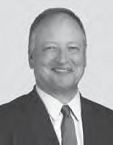
Director since 2008; COMMITTEES:
| CURRENT AND PAST POSITIONS
Positions with McKinsey & Company:
| QUALIFICATIONS AND SKILLS
OTHER DIRECTORSHIPS
| ||
| MARSHALL B. FARRER | ||||

Director since 2016
| CURRENT AND PAST POSITIONS
Positions with Brown-Forman and affiliates:
• Led the global Jack Daniel’s Tennessee Honey brand team from 2014 to 2015
• Founding member of Brown-Forman/Brown Family Shareholders Committee
| QUALIFICATIONS AND SKILLS
• A history of service on the | ||
| LAURA L. FRAZIER | ||||

Director since 2016
| CURRENT AND PAST POSITIONS
Bittners LLC(a more than 160-year-old interior and commercial design firm), Owner, Chairman, and past-CEO
Positions with Brown-Forman and affiliates:
| QUALIFICATIONS AND SKILLS
| ||
 | 18BROWN-FORMAN 2019 PROXY STATEMENT AND NOTICE OF ANNUAL MEETING OF STOCKHOLDERS |
ELECTION OF DIRECTORS •Election of Directors NOMINEES| Nominees
| KATHLEEN M. GUTMANN | ||||

Director since 2017 COMMITTEES:
| CURRENT AND PAST POSITIONS
Positions with United Parcel Service:
| QUALIFICATIONS AND SKILLS
• Experience
| ||
| AUGUSTA BROWN HOLLAND | ||||

Director since 2015
| CURRENT AND PAST POSITIONS
| QUALIFICATIONS AND SKILLS
| ||
| MICHAEL J. RONEY | ||||
  Director since 2014 COMMITTEES:
| CURRENT AND PAST POSITIONS
Bunzl plc, Chief Executive Officer from 2005 to 2016 | QUALIFICATIONS AND SKILLS
OTHER DIRECTORSHIPS
| ||
2019 PROXY STATEMENT AND NOTICE OF ANNUAL MEETING OF STOCKHOLDERS |  |
ELECTION OF DIRECTORS •Election of DirectorsNOMINEES | Nominees

Director since 2018 COMMITTEES:
• Audit | CURRENT AND PAST POSITIONS Positions with Yum! Brands, Inc. and affiliates: • Chief Transformation and People Officer, Yum! Brands, Inc. since 2016 • President, Pizza Hut International from 2014 to 2015 • Chief People Officer, Pizza Hut Global from 2013 to 2014 • Chief People Officer, Pizza Hut US from 2011 to 2013 | QUALIFICATIONS AND SKILLS • Strong track record of business leadership overseeing transformation strategy, human resources, and corporate communications functions • Experience leading business transformation and global people capability strategies to build powerful brands and fuel sustainable results • Extensive accounting, treasury, and financial expertise | ||
| MICHAEL A. TODMAN | ||||
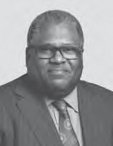 Director since 2014 COMMITTEES:
| CURRENT AND PAST POSITIONS
Positions with Whirlpool and affiliates:
| QUALIFICATIONS AND SKILLS
OTHER DIRECTORSHIPS
| ||

Director since November 2018 COMMITTEES:
| CURRENT AND PAST POSITIONS
Positions with Brown-Forman and affiliates:
• Executive Vice President and Chief Operating Officer from
• Senior Vice President and Chief Brands Officer from 2013 to 2015 • Senior Vice President and Managing Director for • Vice President and Finance Director for Western Europe from 2010 to 2011 • Vice President and Finance Director for North America from 2009 to 2010 | QUALIFICATIONS AND SKILLS
| ||
Family relationships.No family relationship — first cousin or closer — exists between any two directors, executive officers, or individuals nominated or chosen to become a director or executive officer, except for the following relationships between Brown family directors: Geo. Garvin Brown IV and Campbell P. Brown are brothers, and Marshall B. Farrer is their first cousin; and Stuart R. Brown and Augusta Brown Holland are first cousins.
 | 20BROWN-FORMAN 2019 PROXY STATEMENT AND NOTICE OF ANNUAL MEETING OF STOCKHOLDERS |


OVERVIEW
Our directors serve one-year terms that begin with their electionwhen they are elected at an Annual Meeting and end immediately upon the election of directors at the next Annual Meeting. We refer to this period as a “Board Year” for director compensation purposes.
Our non-employee director compensation consists of an annual Board retainer, a Chair of the Board retainer, a Lead Independent Director retainer, committee member retainers, committee chair retainers, and meeting fees. To align the interests of our non-employee directors with those of our stockholders, non-employee directors receive their Board retainers in a combination of cash and equity. Non-employee directors receive meeting fees only if they attend more than eight meetings (Board), ten meetings (Audit Committee), or six meetings (Compensation Committee and Corporate Governance &and Nominating Committee). The Compensation Committee believes this compensation structure appropriately reflects the importance of directors’ active participation at Board and committee meetings.
The Compensation Committee reviews, with the assistance of its independent consultant, Frederic W. Cook & Co. (FWC)FWC, information each year related to the competitiveness of our non-employee Director compensation and, fromdirector compensation. From time to time, the Compensation Committee recommends adjustments to itsour compensation structure to ensure both continued competitiveness and the appropriate level and mix of compensation. Based upon the review of this informationconducted in fiscal 2017,2019, and with the advice of FWC, the Compensation Committee recommended to the Board, and the Board confirmed and approved, nothe following changes to the existing retainers and fees listed below.director compensation:
| • | increase the Lead Independent Director Retainer by $15,000; and |
| • | increase the annual Board equity retainer by $20,000. |
These changes are intended to better align compensation levels with those of our compensation comparator group.
| DIRECTOR COMPENSATION STRUCTURE | ||||
| Pay Element | Amount | |||
| Lead Independent Director Retainer | $45,000 | |||
| Paid in six installments over the Board Year. | ||||
Board Retainer Directors may elect to receive their cash retainer in equity. Directors who have satisfied our stock ownership guidelines may elect to receive up to 100% of the retainer in cash | $ • $70,000 cash • (deferred stock units) | |||
Meeting Fees No fee is paid unless the director attends more than eight meetings (Board). | Board | $5,000 per meeting $2,500 per telephonic meeting | ||
| No fee is paid unless the director attends more than ten meetings or six meetings (Compensation and Corporate Governance | Audit, Compensation, and Corporate Governance | $2,500 per meeting $1,250 per telephonic meeting | ||
| Committee Member Retainers | Audit Committee | $25,000 | ||
| Paid in six installments over the Board Year. | Compensation Committee | $20,000 | ||
| Corporate Governance | $20,000 | |||
| Committee Chair Retainers ( excluding Executive Committee) | $20,000 | |||
| Paid in six installments over the Board Year. | ||||
| The Committee Chair Retainer is in addition to the Committee Member Retainer. | ||||
| Non-Employee Chair of the Board Retainer | $625,000 | |||
| Paid in six installments over the Board Year. | ||||
2019 PROXY STATEMENT AND NOTICE OF ANNUAL MEETING OF STOCKHOLDERSBROWN-FORMAN21 |  |
DIRECTOR COMPENSATION • Director CompensationOVERVIEW| Overview
Deferred Stock Units
Our Deferred Stock Unit (DSU) program for non-employee directors allows us to issue both Class A common DSUs and Class B common DSUs. Each DSU represents the right to receive one share of Brown-Forman’s Class A or Class B common stock, based on the closing price of the shares on the date the award is made. After a non-employee director’s Board service ends, his or her DSUs are paid out in shares of Class A or Class B common stock following a six-month waiting period. Directors may elect to receive this distribution either in a single lump sum or in ten equal annual installments.
On each dividend payment date, non-employeeNon-employee directors are credited with the cash dividends on the number of shares represented by the DSUs they held on the record date for that dividend. These dividend credits are converted to additional DSUs based on the market value of the Class A or Class B common stock as of the dividend payment date.
If a director’s Board service ends during a Board Year, the DSUs attributable to the remainder of that Board Year do not vest and are forfeited.
Employee Directors
Paul C. Varga,
Lawson E. Whiting, Campbell P. Brown, and Marshall B. Farrer are our employee directors. They do not receive any compensation for serving on our Board, any of its committees, or on the boards or equivalent bodies of any of our subsidiaries.
Stock Ownership Guideline
Our stock ownership guideline for non-employee directors is equal to five times the annual board retainer, which in fiscal 2017for the 2019 Board Year was $925,000.$1,025,000. When considering whether a non-employee director has satisfied the stock ownership guideline, the Compensation Committee includes DSUs as well as Class A or Class B common stock held directly.directly and DSUs. The value of any unexercised stock-settled stock appreciation rights (SSARs) is not included. Any non-employee director who has not yet met the stock ownership guideline must elect towill receive at least 60% of his or her annual equity boardBoard retainer in DSUs.
Expense Reimbursement
We reimburse all directors for reasonable and necessary expenses they incur in performing their duties as directors.connection with attending Brown-Forman Board and committee meetings. In addition, we provide a travel stipend of $3,000 per meeting to directors who must travel to an overseas location for such Board meetings from outside the United States.and committee meetings.
Continuing Education Allowance
Brown-Forman covers the cost, up to $10,000 per director per Board Year, of continuing education programs to support our directors’ efforts to remain current on best practices in board governance, industry matters, or other business topics relevant to their Board service.
Events
We occasionally invite our directors and their spouses to certain events, including strategy retreats, retirement celebrations, award dinners, and similar functions. We believe these occasions provide valuable opportunities for our directors to establish and develop relationships with our senior executives, long-term stockholders, employees, and each other, furthering our objective of having a strong and cohesive board.
22BROWN-FORMAN2019 PROXY STATEMENT AND NOTICE OF ANNUAL MEETING OF STOCKHOLDERS
 |
|
DIRECTOR COMPENSATION • Director CompensationFISCAL 2017 DIRECTOR COMPENSATION | Fiscal 2019 Director Compensation
FISCAL 20172019 DIRECTOR COMPENSATION
The following table shows the compensation paid to non-employee directors for their service in fiscal 2017.
FISCAL 2017 DIRECTOR COMPENSATION TABLE2019.
| FISCAL 2019 DIRECTOR COMPENSATION TABLE | FISCAL 2019 DIRECTOR COMPENSATION TABLE | ||||||||||||||||||||||
| Name | Fees Earned or Paid in Cash(1) | DSU Awards(2)(3) | All Other Compensation(4) | Total | Fees Earned or Paid in Cash(1) | DSU Awards(2)(3) | All Other Compensation(4) | Total | |||||||||||||||
| Joan C. Lordi Amble(5) | $13,615 | $— | $— | $13,615 | |||||||||||||||||||
| Patrick Bousquet-Chavanne | 59,394 | 185,000 | 15,000 | 259,394 | $163,323 | $115,000 | $12,000 | $290,323 | |||||||||||||||
| Geo. Garvin Brown IV | 517,727 | 312,500 | 18,000 | 848,227 | 532,500 | 312,500 | 18,000 | 863,000 | |||||||||||||||
| Martin S. Brown Jr.(5) | 45,066 | — | — | 45,066 | |||||||||||||||||||
| Stuart R. Brown | 185,227 | — | — | 185,227 | 149,375 | 57,500 | — | 206,875 | |||||||||||||||
| Bruce L. Byrnes | 116,477 | 115,000 | — | 231,477 | 115,000 | 115,000 | — | 230,000 | |||||||||||||||
| John D. Cook | 115,158 | 185,000 | — | 300,158 | 257,500 | — | — | 257,500 | |||||||||||||||
| Laura L. Frazier | 172,567 | — | — | 172,567 | 200,000 | — | — | 200,000 | |||||||||||||||
| Sandra A. Frazier(5) | 45,066 | — | — | 45,066 | |||||||||||||||||||
| Kathleen M. Gutmann | 95,000 | 115,000 | — | 210,000 | |||||||||||||||||||
| Augusta Brown Holland | 85,227 | 115,000 | — | 200,227 | 70,000 | 115,000 | — | 185,000 | |||||||||||||||
| Michael J. Roney | 26,061 | 185,000 | 18,000 | 229,061 | 95,000 | 115,000 | 18,000 | 228,000 | |||||||||||||||
| Tracy L. Skeans(5) | 25,000 | 253,701 | — | 278,701 | |||||||||||||||||||
| Michael A. Todman | 115,133 | 115,000 | — | 230,133 | 115,000 | 115,000 | — | 230,000 | |||||||||||||||
| Paul C. Varga(6) | 68,333 | — | — | 68,333 | |||||||||||||||||||
| (1) | Amounts in this column reflect fees earned during fiscal |
| (2) | DSUs represent the right to receive one share of Class A or Class B common stock, and are determined by dividing the cash value of the compensation being paid in DSUs by the closing price of Class A or Class B common stock on the date of grant. DSU awards for the |
| (3) | The aggregate number of SSARs |
| Name | DSUs Outstanding Class A as of April 30, 2017 | DSUs Outstanding Class B as of April 30, 2017 | Class B SSAR Outstanding as of April 30, 2017 | Class B Time-Based Restricted Stock Units as of April 30, 2017 | ||||
| Joan C. Lordi Amble | 9,179 | 4,252 | — | — | ||||
| Patrick Bousquet-Chavanne | 15,773 | 10,526 | — | — | ||||
| Geo. Garvin Brown IV | 12,485 | — | 12,512 | 7,612 | ||||
| Martin S. Brown, Jr. | — | 3,163 | 24,494 | — | ||||
| Stuart R. Brown | — | — | — | — | ||||
| Bruce L. Byrnes | 9,747 | 6,831 | — | — | ||||
| John D. Cook | 15,773 | 10,526 | 43,504 | — | ||||
| Laura L. Frazier | — | — | — | — | ||||
| Sandra A. Frazier | — | 3,163 | 24,494 | — | ||||
| Augusta Brown Holland | 3,424 | — | — | — | ||||
| Michael J. Roney | 11,909 | — | — | — | ||||
| Michael A. Todman | 8,259 | — | — | — |
| Name | DSUs Outstanding Class A as of April 30, 2019 | DSUs Outstanding Class B as of April 30, 2019 | Class B SSARs Outstanding as of April 30, 2019 | ||||
| Patrick Bousquet-Chavanne | 20,926 | 18,442 | — | ||||
| Geo. Garvin Brown IV | 25,105 | 4,817 | — | ||||
| Stuart R. Brown | 1,071 | — | — | ||||
| Bruce L. Byrnes | 14,626 | 12,042 | — | ||||
| John D. Cook | 20,178 | 18,790 | 12,188 | ||||
| Kathleen M. Gutmann | 4,868 | 681 | — | ||||
| Augusta Brown Holland | 8,014 | 1,467 | — | ||||
| Michael J. Roney | 18,282 | 4,032 | — | ||||
| Tracy L. Skeans | 4,727 | — | — | ||||
| Michael A. Todman | 13,070 | 2,730 | — |
| (4) | Reflects taxable |
| (5) | |
| (6) | Paul C. |
2019 PROXY STATEMENT AND NOTICE OF ANNUAL MEETING OF STOCKHOLDERSBROWN-FORMAN23
|  |

This section describes our executive compensation philosophy and objectives, and the decisions of the Compensation Committee (Committee) regarding the compensation of our Named Executive Officers (NEOs). For fiscal 2017,2019, our NEOs were:
Lawson E. Whiting President and Chief Executive Officer(1) | ||||||
Jane C. Morreau | Executive Vice President and Chief Financial Officer | |||||
Mark I. McCallum | Executive Vice President | |||||
Matthew E. Hamel Executive Vice President, General Counsel and Secretary | Thomas Hinrichs Senior Vice President, | Paul C. Varga Former Company Chairman and |
| (1) | Mr. Whiting became Chief Executive Officer effective January 1, 2019 and became President effective March 28, 2019. |
Pay for Performance
We believe in pay for performance through our short- and long-term incentive programs.programs should drive performance. These programs utilize key performance metrics to compare our performance to that of our peers. We believe the use of these metrics:metrics accomplishes four key objectives:
 | demonstrating value provided to our | |||||||||
 | ensuring that we hold ourselves to | |||||||||
 | reinforcing a competitive and innovative mindset among our | |||||||||
 | ensuring that |
We believe one of the best measures of value to the Company created by our NEOs create is the return provided to our stockholders relative to the returns of other companies in our industry and the broader S&P 500, as shown in the charts below:
| BROWN-FORMAN TOTAL SHAREHOLDER RETURN (TSR) VS. EARNINGS PER SHARE (EPS) VS. CEO TOTAL COMPENSATION GROWTH(1) |
| |
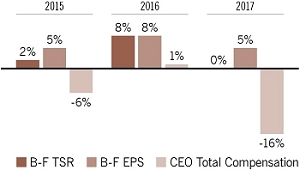 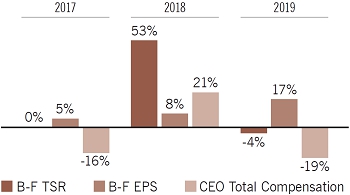 | 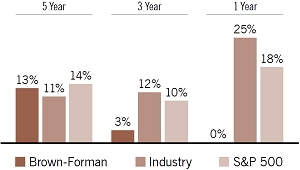 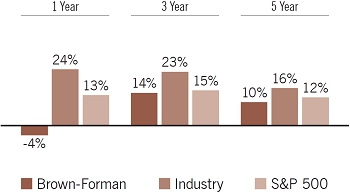 |
| (1) | Compares |
| (2) | Represents the compound annual growth rate of TSR. Industry |
 | 24BROWN-FORMAN 2019 PROXY STATEMENT AND NOTICE OF ANNUAL MEETING OF STOCKHOLDERS |
COMPENSATION DISCUSSION AND ANALYSIS • OVERVIEW OF OUR COMPENSATION PROGRAM | EXECUTIVE SUMMARY
As a result
Every year, the Committee evaluates NEO compensation in comparison to the compensation of theexecutives with equivalent positions within our industry. (This process is described below under “How We Set Target Compensation for Our NEOs.”) The Committee’s 2019 annual review process, it was determinedrevealed that the total target direct compensation for our NEOs was below the market median when compared tofor our compensation peer group listed on page 28.29. In light of this review, we believe our executive compensation program delivers exceptional value to our stockholders, particularly considering the combination of strong returns and financial performance that Brown-Forman and itsour management team have delivered over multiple years.
Performance-Based Payouts for Fiscal 20172019
Brown-Forman performance in fiscal 2017 reflected
Our compensation program demonstrates the close alignment between executive compensationpay and Brown-Forman’s performance.

CASH INCENTIVES
EQUITY-BASED INCENTIVES
We use equity-based compensation to align the long-term economic interests of our executivesNEOs with those of our stockholders. We offer our NEOs two types of equity-based incentives: performance-based restricted Class A common stock or stock units, and stock-settled stock appreciation rights settled in shares of Class B common stock.rights.
| • | Performance-based restricted stock awards for the fiscal | Our relative performance against this group over the performance period was at the | |
| • | Payouts of our stock-settled stock appreciation rights are determined by the increase of our Class B common stock price above the awards’ stated grant price. | ||
Advisory Votes on Executive Compensation
In
We conduct an advisory vote on our firstexecutive compensation (“say-on-pay”) every three years. Our last “say-on-pay” vote inoccurred at our 20142017 Annual Meeting, and our stockholders expressed overwhelming support for the compensation of our NEOs, with more than 99% of the votes cast approving the advisory “say-on-pay” resolution. The Committee considered these results as one of many factors in its executive compensation decisions for fiscal 2015, 2016,2018 and 2017,2019, and did not make any material changes to the executive compensation program.
Following the expressed preference of our stockholders, who approved an advisory resolution favoring a three-year frequency for advisory say-on-pay votes at our 2017 Annual Meeting, Brown-Forman expects towill continue to conduct future advisory votes on executive compensation every three years, but reservesyears. We expect that our next say-on-pay vote will occur at our 2020 Annual Meeting. However, we reserve the right to conduct votes more frequently in order to seek additional feedback from our stockholders. As in past years, the Committee will consider the results of this year’s “say-on-pay” advisory vote (Proposal 2 on page 51) in its future executive compensation decisions.when warranted.
2019 PROXY STATEMENT AND NOTICE OF ANNUAL MEETING OF STOCKHOLDERSBROWN-FORMAN 25
COMPENSATION DISCUSSION AND ANALYSIS | OVERVIEW OF OUR COMPENSATION PROGRAM

| Our company vision is “Building Forever,” which reflects our long-term perspective and desire to remain a strong, independent company indefinitely. We aim to “enrich the experience of life by responsibly building beverage alcohol brands, in our own way, that thrive and endure for generations.” We have identified specific strategic ambitions, known as the BF 150, that support our mission and vision as they represent objectives we believe are necessary to position our enterprise for success in the year 2020, coinciding with our 150th anniversary. These priorities include: | |
| • | Building brands and businesses that create stockholder value; |
| • | Keeping Jack Daniel’s Tennessee Whiskey strong, healthy, and relevant to consumers worldwide; |
| • | Continuing to be the global leader in American whiskey; |
| • | Cultivating a portfolio of super premium brands; |
| • | Growing our business in the United States, our largest market; |
| • | Growing our non-U.S. developed and emerging markets; |
| • | Engaging our stockholders, including our controlling family stockholders; |
| • | Pursuing well-balanced capital deployment strategies; and |
| • | Being responsible in everything we do. |
OVERVIEW OF OUR COMPENSATION PROGRAM
Compensation Objectives and Principles
The objective of our executive compensation program is to attract, motivate, reward, and retain a diverse team of talented executives who will lead Brown-Forman to produce superior, sustainable, long-term value for our stockholders.
As a family-controlled company, our history guides our perspective on executive compensation. Members of the Brown family have historically served as our senior leadership, and their compensation was modest by competitive market standards. While this was not a major concern at the time given their significant stock holdings, in recent years employees other than Brown family members have more frequently held our most senior executive positions. These individuals have less substantial ownership in the Company and, as a result, our compensation structure has evolved over time to better reflect the competitive landscape for executive talent. In order to remain competitive, as well as to ensure our alignmentcompensation packages are aligned with the interests of the Brown Familyfamily and our other stockholders, we believe we have established programsa program that remainremains focused on creating long-term value, reinforcing financial accountability, and delivering outstanding operational outcomes to drive sustained performance of Brown-Forman’sBrown-Forman stock.
|  |
COMPENSATION DISCUSSION AND ANALYSIS • OVERVIEW OF OUR COMPENSATION PROGRAM

| |
| |
Compensation Elements
Principal elements of compensation for our NEOs include:
| • | base salary (including holiday bonus); |
| • | short-term (one-year) performance-based cash compensation; |
| • | long-term (three-year) performance-based cash compensation; |
| • | long-term equity-based incentive compensation (stock-settled stock appreciation rights and performance-based restricted |
| • | benefits and limited perquisites |
| • | limited post-employment compensation and other benefits. |
Measuring Performance
To measure financial performance, we use a metric called “underlying operating income.” This numbermetric is determined by adjusting GAAP operating income for the effecteffects of acquisitions and divestitures, foreign currency changes, the effect of estimated net changes in distributor inventories for our brands, and the effectestablishment of acquisitions and divestitures.our charitable foundation. Please refer to Appendix A at the end of this Proxy Statement for additional information.
The Committee believes the most relevant measures of our performance are:
| • | strong and sustained growth in underlying operating income, both on an absolute basis and relative to industry peers, |
| • | progress toward our long-term strategic goals, and |
| • | our three-year |
26BROWN-FORMAN2019 PROXY STATEMENT AND NOTICE OF ANNUAL MEETING OF STOCKHOLDERS
COMPENSATION DISCUSSION AND ANALYSIS | THE ROLE OF OUR COMPENSATION COMMITTEE
FISCAL 2019 PERFORMANCE METRICS FOR BROWN-FORMAN INCENTIVE PLANS
| Performance-Based Component | Performance Measures | |
| Short-Term Cash Incentive | 80% Weighting: Underlying operating income growth(1)relative to expected performance among industry peers | |
| 20% Weighting: Individual performance | ||
| Long-Term Cash Incentive | 30% Weighting: Underlying operating income growth compared to sustained growth of 8% | |
| 30% Weighting: Underlying operating income growth compared to industry peers | ||
| 40% Weighting: Progress toward long-term quantitative and qualitative strategic goals | ||
| Performance-Based Restricted Stock | TSR relative to S&P Consumer Staples Index | |
| Stock-Settled Stock Appreciation Rights | Stock price growth above grant price | |
| (1) | “Underlying operating income” is not derived in accordance with GAAP. |
Competitive Compensation
We aspire to provide target compensation for our NEOs that approximates median target compensation delivered to executives in similar positions at companies we consider competition for senior executive talent. We believe that providing strong, competitive target compensation aligned with performance enhances our ability to secure the right executive leadership while driving the right results for our stockholders.
To help ensure we meet this objective, the Committee compares Brown-Forman’s compensation practices with those of a group of high-performing, brand-building consumer products companies with similar financial characteristics. The Committee reviews this group of companies annually to ensure they continue to meet these criteria. These companies are listed on page 28.
 |
|
COMPENSATION DISCUSSION AND ANALYSIS • TARGET COMPENSATION29.
THE ROLE OF OUR COMPENSATION COMMITTEE
The Committee serves a critical role in our compensation governance. Throughgovernance by providing independent oversight and thought leadership on executive compensation and its relationship to Company performance, the Committee establishesestablishing performance objectives that correlate pay and performance. The Committee, with the assistance of its independent compensation consultant, FWC, establishes compensation for our NEOs and other designated executive officers, and helps the Board fulfill its duties relating to the compensation of our directors, officers, and employees. The Committee also has the sole authority, on behalf of the Board, to determine the compensation of our CEO. Pursuant to its charter, the Committee may delegate to the Management Compensation and Benefits Committee, or to one or more company officers, the authority to make equity awards to other eligible individuals. The Committee may change or revoke any delegation at any time.
The Committee is composed of three independent directors — Messrs. Roney (Chair), Bousquet-Chavanne, and Cook. Each member of the Committee qualifies as an independent director under the NYSE’s heightened independence standards for Compensation Committeecompensation committee members of non-controlled companies, as a non-employee director under SEC rules, and as an outside director under regulations adopted pursuant to Section 162162(m) of the Internal Revenue Code. As a “controlled company,” Brown-Forman is not required to meet all of these standards, but we believe that doing so is in the best interests of our Companycompany and our stockholders.
The Committee’s deliberations and decisions are informed by the diverse experience of its members, input from certain members of management, advice from FWC, and access to functional experts in our human resources department.at the company.
Sound Pay Practices
We avoid pay practices that we believe do not support the objectives of our executive compensation program or our culture. We do not offer NEOs employment agreements, non-performance-based cash payments (other than base salary and holiday bonus), tax gross-ups, excessive perquisites, or severance or change-in-control agreements. We also have an Incentive Compensation Recoupment Policy (commonly known as a “clawback” policy) that permits Brown-Forman to seek recovery of incentive compensation paid or awarded in the event ofwe restate a subsequent financial restatement due tofiling because of material noncompliance with financial reporting requirements or the discovery ofwe discover an error in the calculation of thethat incentive compensation that was awarded or paid.compensation.
Each year, we assess and evaluate potential compensation-related risks. Based upon this year’s review, management and the Committee have concluded that our compensation policies and practices do not create any risk that is reasonably likely to have a material adverse effect on Brown-Forman. This is our intent and it is consistent with our findings in prior years.
2019 PROXY STATEMENT AND NOTICE OF ANNUAL MEETING OF STOCKHOLDERSBROWN-FORMAN 27
COMPENSATION DISCUSSION AND ANALYSIS | TARGET COMPENSATION
The Compensation Consultant
As an independent compensation advisor, FWC reports directly to the Committee and attends meetings as requested. FWC provides the Committee with information on external compensation trends and guidance on the compensation of our CEO and other NEOs, and also reviews this Compensation Discussion and Analysis. In addition, FWC provides independent advice to the Board on director remuneration, assists with the Board and Committeecommittee self-assessment process, and acts as the Committee’s advisor in working with management. FWC provides no other services to Brown-Forman or management.
In accordance with SEC and NYSE requirements, the Committee has reviewed the independence of FWC and determined that no conflict exists that would compromise the independence of the advice the firm provides.
How We Set Target Compensation for Our NEOs
We apply a customized approach to determine the target compensation offor each NEO. We consider each NEO’s role, the value of the role in the labor market, and factors specific to the NEO as an individual. Individual factors include tenure with Brown-Forman, mastery of current role, potential to move into expanded roles, performance, scarcity of skill-sets,skill sets, retention risk, fit within our culture, career experience, and internal pay equity. We find that this approach leads to a more effective pay program than one based solely based on external labor market data.
To ensure our pay is competitive, we compare NEO compensation with the compensation for executives in similar positions within aour compensation comparator group of high-performing, brand-building consumer products companies with financial characteristics similar to those of Brown-Forman.group. FWC prepares a market analysis comparing the target value of each element of compensation for Brown-Forman’s NEOs to the compensation paid by theour compensation comparator group. This analysis produces a range of market-competitive levels of target compensation as one consideration in determining pay for our
|  |
COMPENSATION DISCUSSION AND ANALYSIS • TARGET COMPENSATION
NEOs. While we do not set target compensation to meet specific benchmarks, we do consider the median of the comparator group as a guide to appropriate target pay ranges for our NEOs.
To determine the pay elements that make up each NEO’s target compensation, we begin by reviewing a preferred “pro-forma”the pay mix of pay developed and recommended by FWC.our compensation comparator group. The objective of this practice is to have a pay mix that aligns from anour internal perspective and supportswith the comparator group, while supporting our goal of promoting shareholderstockholder value. FWC and the Committee periodically review the “pro-forma”pay mix to ensure we maintain this continued alignment.
BROWN-FORMAN CEO AND NEO PAY MIX VS. COMPENSATION COMPARATOR GROUP
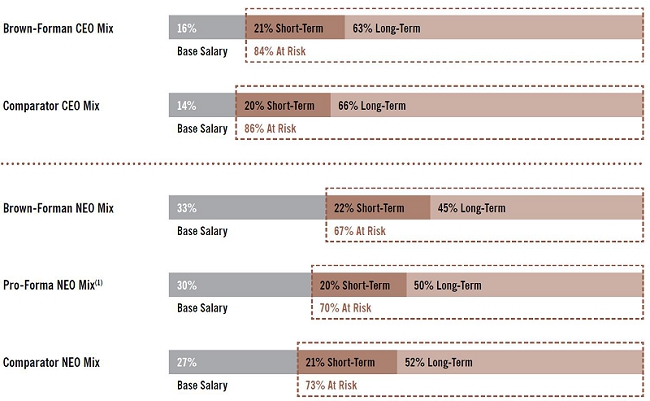

28BROWN-FORMAN 2019 PROXY STATEMENT AND NOTICE OF ANNUAL MEETING OF STOCKHOLDERS
COMPENSATION DISCUSSION AND ANALYSIS | AWARDS AND PAYOUTS IN FISCAL 2019: FIXED AND SHORT-TERM COMPENSATION
Compensation Comparator Group
During fiscal 2017,
Each year, the Committee reviewedreviews the membership of the compensation comparator group to ensure continued alignment with the characteristics of Brown-Forman. As a result of thisthe most recent review, Keurig Green MountainDr. Pepper Snapple Group, Inc. and Pinnacle Foods Inc. were removed from the comparator group, and Tiffany & Co. was removedadded. The companies shown below constituted the compensation comparator group for decisions made as they were recently acquired.of March 21, 2019.
| Church & Dwight Co., Inc. | Harley Davidson Inc. | Monster Beverage Corporation | The J.M. Smucker Company | |||
| ConAgra Brands, Inc. | Hershey Co. | |||||
| Constellation Brands, Inc. | ||||||
| lululemon athletica inc. | ||||||
| McCormick & Company, Incorporated | The Hain Celestial Group, Inc. | |||||
| Diageo Plc | The Hershey Company |
 |
|
COMPENSATION DISCUSSION AND ANALYSIS •
AWARDS AND PAYOUTS IN FISCAL 2017: FIXED AND SHORT-TERM COMPENSATION
Target Total Direct Compensation for Fiscal 20172019
The chart below shows the annualized target total direct compensation for each of our NEOs in fiscal 20172019 versus fiscal 2016,2018, and the percentage increase of each component.the compensation packages.
FISCAL 20172019 VERSUS FISCAL 20162018 NEO TARGET TOTAL DIRECT COMPENSATION
| ■ Salary and | ■ Short-Term | ■ Long-Term | Target Total | Percent | ||||||||||||||||||||||||
| Name | Year | Holiday Bonus(1) | Incentive Target | Incentive Target | Direct Comp | Increase | Pay Mix at Target | Year |  Salary and Salary andHoliday Bonus(1) |  Short-Term Short-TermIncentive Target |  Long-Term Long-TermIncentive Target | Target Total Direct Comp | Percent (+/-) | Pay Mix at Target | ||||||||||||||
| Paul C. Varga | 2017 | 1,145,870 | 1,455,000 | 4,400,000 | 7,000,870 | 4% |  | |||||||||||||||||||||
| Lawson E. Whiting(2) | 2019 | $899,113 | $850,000 | $1,666,667 | $3,415,780 | 89% |  | |||||||||||||||||||||
| 2016 | 1,133,370 | 1,400,000 | 4,200,000 | 6,733,370 |  | 2018 | 625,099 | 390,027 | 795,833 | 1,810,959 |  | |||||||||||||||||
| Jane C. Morreau | 2017 | 598,978 | 420,000 | 900,000 | 1,918,978 | 5% |  | 2019 | 625,020 | 450,000 | 1,050,000 | 2,125,020 | 11% |  | ||||||||||||||
| 2016 | 572,935 | 400,000 | 850,000 | 1,822,935 |  | 2018 | 598,978 | 420,000 | 900,000 | 1,918,978 |  | |||||||||||||||||
| Mark I. McCallum | 2017 | 661,480 | 450,000 | 860,000 | 1,971,480 | 2% |  | 2019 | 681,324 | 463,500 | 885,800 | 2,030,624 | 3% |  | ||||||||||||||
| 2016 | 645,854 | 440,000 | 850,000 | 1,935,854 |  | 2018 | 661,480 | 450,000 | 860,000 | 1,971,480 |  | |||||||||||||||||
| Jill A. Jones | 2017 | 614,603 | 440,000 | 840,000 | 1,894,603 | 4% |  | |||||||||||||||||||||
| Matthew E. Hamel | 2019 | 536,476 | 309,000 | 654,050 | 1,499,526 | 3% |  | |||||||||||||||||||||
| 2016 | 598,978 | 430,000 | 800,000 | 1,828,978 |  | 2018 | 520,850 | 300,000 | 635,000 | 1,455,850 |  | |||||||||||||||||
| Lawson E. Whiting | 2017 | 494,808 | 300,000 | 650,000 | 1,444,808 | 9% |  | |||||||||||||||||||||
| Thomas Hinrichs(3) | 2019 | 478,965 | 410,364 | 482,782 | 1,372,111 | 14% |  | |||||||||||||||||||||
| 2016 | 447,931 | 275,000 | 600,000 | 1,322,931 |  | 2018 | 458,796 | 361,850 | 383,160 | 1,203,806 |  | |||||||||||||||||
| Paul C. Varga(4) | 2019 | 812,478 | 1,006,920 | 3,024,267 | 4,843,665 | -31% |  | |||||||||||||||||||||
| 2018 | 1,145,870 | 1,455,000 | 4,400,000 | 7,000,870 |  | |||||||||||||||||||||||
| (1) | Salary and holiday bonus are based on the one-year period beginning on July 1. Other compensation elements are based on our fiscal year beginning May 1. Any change to compensation during the year is |
| (2) | Mr. Whiting’s increase in compensation was the result of his promotion to Chief Executive Officer effective January 1, 2019. |
| (3) | Mr. Hinrichs is based in Amsterdam, Netherlands and paid in euros. The amount shown has been converted to U.S. dollars. |
| (4) | Mr. Varga retired from Brown-Forman on December 31, 2018. Amounts shown reflect his pro-rated compensation based on his retirement date. |
AWARDS AND PAYOUTS IN FISCAL 2017:2019: FIXED AND SHORT-TERM COMPENSATION
Fixed Compensation
Base salary.Salaries typically are typically adjusted each July following completion ofafter we complete our annual performance review process, thoughbut an NEO’s salary may be adjusted during the fiscal year if he or she experiencesat other times to reflect a change in role or responsibility.
Holiday bonus.One of our longstanding traditions is to offer a majority of our employees, including our NEOs, a lump-sum cash bonus during the holiday season. The intent of thisThis bonus is intended to promote continued service and likewise to recognizeshow appreciation for our employees. The holiday bonus, which we consider to be part of base salary, is guaranteed and based solely on the employee’s length of servicetenure with Brown-Forman.
2019 PROXY STATEMENT AND NOTICE OF ANNUAL MEETING OF STOCKHOLDERSBROWN-FORMAN 29
COMPENSATION DISCUSSION AND ANALYSIS | AWARDS AND PAYOUTS IN FISCAL 2019: FIXED AND SHORT-TERM COMPENSATION
The table below shows the total amount of fixed compensation that each of our NEOs received in fiscal 2017.2019.
FIXED COMPENSATION FOR 2019(1)
| Amount | ||
| Lawson E. Whiting | $872,374 | |
| Jane C. Morreau | 620,842 | |
| Mark I. McCallum | 678,140 | |
| Matthew E. Hamel | 533,969 | |
| Thomas Hinrichs(2) | 477,044 | |
| Paul C. Varga(3) | ||
| (1) | Reflects fiscal year fixed compensation from May 1, |
|  |
| (3) |
COMPENSATION DISCUSSION AND ANALYSIS •
AWARDS AND PAYOUTS IN FISCAL 2017: FIXED AND SHORT-TERM COMPENSATION
Short-Term Incentive Compensation
Our NEOs participate in an annual performance-based cash compensation program in which payouts depend on the achievement of certain performance goals during the fiscal year.
For fiscal 2017,2019, 80% of the target award was tied to Brown-Forman’s Companycompany performance and 20% was tied to individual performance. We believe basing the majority of short-term incentive awards for NEOs on Companycompany performance appropriately reflects the collective accountability of our most senior executives for the performancesuccess of the enterprise.organization. We also believe that basing a lesser, but meaningful, portion of the short-term incentive on individual performance provides flexibility to differentiate awards among NEOs based on their individualrespective achievements during the fiscal year.
Both the corporate and individual portions of our short-term incentives are subject to a performance factor of 0% to 200%. After adjusting for performance, the two components are added together to determine the total short-term incentive payment. As a result, the total value of short-term incentives may vary between 0% and 200% of target, which is a range we believe to beis sufficient infor recognizing our varying levels of performance while notwithout encouraging excessive risk-taking.
Please see the “Non-Equity Incentive Plan Compensation” column of the Fiscal 2019 Summary Compensation Table for Fiscal 2017 found on page 40 for the amounts paid to NEOs in short-term incentive compensation for fiscal 2017.2019.
COMPANY PERFORMANCE (80% OF TARGET AWARD)
Company performance goals for fiscal 20172019 were based on Brown-Forman’s underlying operating income growth compared to the expected performance of our industry peers. We aspire to outperform these peers consistently and sustainably, and considerconsidered our historic underlying operating income growth trends and outlook for fiscal 20172019 performance when setting these objectives.
The Committee determined that, for purposes of the short-term incentive compensation plan, Brown-Forman achieved underlying operating income of $1,006$1,157 million for fiscal 2017 (on2019, which represents 5% growth over last year, compared to an as-reported basis, fiscal 2017 operating income was $989 million) resulting inexpected growth rate of 6% for our industry peers. As shown on the next page, these results led to a payout of 127%87% of target.target for this portion of the short-term incentive.
Underlying operating income at Brown-Forman was calculated by adjusting GAAP operating income for the following effects:
| • | foreign currency changes; |
| • | estimated net changes in distributor inventories for our brands; and |
| • |
We explain why“Underlying operating income” is not derived in accordance with GAAP. Please refer to Appendix A at the Company uses underlying operating income in Part II, Item 7, “Management’s Discussion and Analysisend of Financial Condition and Results of Operations,” under the heading “Non-GAAP Financial Measures,” in our Annual Report on Form 10-Kthis Proxy Statement for fiscal 2017.additional information.
The fiscal 2017 short-term performance goal, our actual performance, and the resulting payout percentage of 127% of target is shown in the chart below:30BROWN-FORMAN2019 PROXY STATEMENT AND NOTICE OF ANNUAL MEETING OF STOCKHOLDERS
FISCAL 2017 SHORT-TERM INCENTIVE COMPENSATION PERFORMANCE GOAL (IN $MM)

 |
|
COMPENSATION DISCUSSION AND ANALYSIS • | AWARDS AND PAYOUTS IN FISCAL 2017:2019: LONG-TERM COMPENSATION
The fiscal 2019 short-term performance goal, our actual performance, and the resulting payout percentage of 87% of target is shown in the chart below:
FISCAL 2019 SHORT-TERM INCENTIVE COMPENSATION PERFORMANCE GOAL (IN $MM)

INDIVIDUAL PERFORMANCE (20% OF TARGET AWARD)
Individual performance objectives for the NEOs consist of qualitative and quantitative goals that support the achievement of our strategic priorities, such as fulfilling individual job responsibilities, providing diversity and inclusion leadership, implementing talent development, development ofdeveloping profit-driving ideas, implementation ofimplementing BF 150 strategies, and making overall contributions to Brown-Forman as a senior leader. For fiscal 2017, final individual scores were adjusted to ensure a weighted average reflecting overall Company performance, as we believe the organization’s performance is a reflection of the performance of our people. Payout levels for the individual portion of the short-term incentive are based on the following guidelines for aligning performance and compensation:
| Performance(B-F Nomenclature) | Payout as a Percentage of Target |
| Superior(Excellent) | 176%–200% |
| Above Target(Very Strong) | 126%–175% |
| On Target(Strong) | 76%–125% |
| Below Target(Varied or Inconsistent) | Up to 75% |
| Immediate Improvement Required(Performance Needs Improvement) | No incentive paid |
AWARDS AND PAYOUTS IN FISCAL 2017:2019: LONG-TERM COMPENSATION
Long-term incentives are the most important and largest portion of our NEOs’ target compensation. These awards are intended to focus the efforts of our executives on long-range strategic goals, including sustainable growth and performance of our brands, and superior returns to our stockholders. They also serve as a strong retention incentive and enhance the alignment of our executives’ interests with those of our stockholders by building equity ownership.
The Committee initially determines the target dollar value of the total long-term incentive award for each NEO. We then structure ourThe target long-term incentives as follows:are divided equally into four components:
 | 25% performance-based cash | |||
 | 25% stock-settled stock appreciation | |||
 | 25% performance-based restricted stock units |  | 25% any combination of the above, based on the NEO’s preference, subject to Committee |
The Committee has discretion to allocate the flexible 25% portion of the award in any manner it chooses. Traditionally, however, itthe Committee has chosen to follow the individual preferences expressed by our NEOs.each NEO. Our aim with this approach is to encourage balanced performance in order to create sustainable value for stockholders, while also delivering compensation that has the highest perceived value for each individual NEO.
2019 PROXY STATEMENT AND NOTICE OF ANNUAL MEETING OF STOCKHOLDERSBROWN-FORMAN 31
|  |
COMPENSATION DISCUSSION AND ANALYSIS • | AWARDS AND PAYOUTS IN FISCAL 2017:2019: LONG-TERM COMPENSATION
Long-Term Performance-Based Cash Incentive (For
(For the Fiscal 2017–20192019–2021 Performance Period)
We provide our NEOs with an opportunity to earn a cash-based incentive award that is linked to Brown-Forman��sBrown-Forman’s achievement of long-term performance goals. The graphic below shows how we tie this incentive to those goals, utilizing the same performance metrics since fiscal 2013. In fiscal 2016, the Committee changed the weightings of the performance metrics to focus more on strategic initiatives and measures relating to underlying net sales. These revised weightings were used for the awards granted in fiscal 2016 and 2017.goals.
LONG-TERM CASH INCENTIVES FORMULA(1)
To calculate the final payout, we:
| 1. | Assess performance under the three metrics below and calculate a payout percentage for each. |
| 2. | Weight these payout percentages using the weightings shown below. |
| 3. | Add the three weighted percentages to |
| 4. | Multiply each |

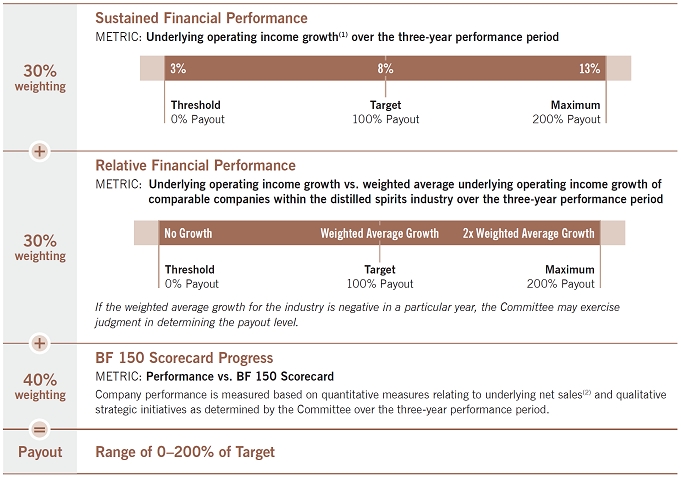
| (1) | |
| (2) | Underlying net sales is a non-GAAP measure and is detailed in Part II, Item 7, “Management’s Discussion and Analysis of Financial Condition and Results of Operations,” under the heading “Non-GAAP Financial Measures,” in our Annual Report on Form 10-K for fiscal |
 | 32BROWN-FORMAN2019 PROXY STATEMENT AND NOTICE OF ANNUAL MEETING OF STOCKHOLDERS |
COMPENSATION DISCUSSION AND ANALYSIS • | AWARDS AND PAYOUTS IN FISCAL 2017:2019: LONG-TERM COMPENSATION
AWARDS GRANTED IN FISCAL 20172019 (FOR THE FISCAL 2017–20192019–2021 PERFORMANCE PERIOD)
Long-term cash incentives granted in fiscal 20172019 have a three-year performance period and, if earned, will be paid shortly following the completion ofafter fiscal 2019.2021 ends. The table below shows the target awards granted to each NEO in fiscal 2017.2019.
TARGET LONG-TERM CASH AWARDS FOR FISCAL 2017–20192019–2021 PERFORMANCE PERIOD
| Name | Amount | |
| $ | ||
| Jane C. Morreau | 420,000 | |
| Mark I. McCallum | 442,900 | |
| 163,513 | ||
| 241,391 | ||
| Paul C. Varga(2) | 1,209,707 |
| (1) | Mr. Hinrichs is based in Amsterdam, Netherlands and paid in euros. The amount shown has been converted to U.S. dollars. |
| (2) | Mr. Varga’s amount is pro-rated for the period of May 1, 2018 to December 31, 2018. See “Treatment of Short-Term and Long-Term Incentive Awards upon Termination of Employment” on page 48. |
AWARDS EARNED IN FISCAL 20172019 (FOR THE FISCAL 2015–20172017–2019 PERFORMANCE PERIOD)
Our long-term cash awards for the three-year performance period beginning in fiscal 20152017 were paid out shortly after fiscal 20172019 ended. Based on our performance, the payout was 143%103% of the target award, calculated as shown in the graphic below:
ACTUAL PERFORMANCE AND PAYOUT FOR FISCAL 2015–20172017–2019 PERFORMANCE PERIOD(1)
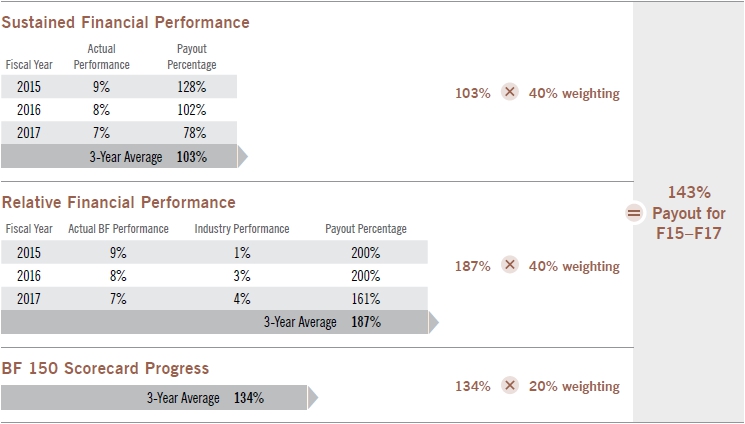

|  |
2019 PROXY STATEMENT AND NOTICE OF ANNUAL MEETING OF STOCKHOLDERSBROWN-FORMAN 33
COMPENSATION DISCUSSION AND ANALYSIS • | AWARDS AND PAYOUTS IN FISCAL 2017:2019: LONG-TERM COMPENSATION
The table below shows the long-term cash award that each NEO earned in fiscal 20172019 based on the 143%103% payout for the fiscal 2015–20172017–2019 performance period.
LONG-TERM CASH AWARDS PAID FOR FISCAL 2015–20172017–2019 PERFORMANCE PERIOD
| Name | Amount | |
| Lawson E. Whiting | $334,750 | |
| Jane C. Morreau | 315,180 | |
| Mark I. McCallum | 442,900 | |
| Matthew E. Hamel | 163,513 | |
| Thomas Hinrichs(1) | 177,595 | |
| Paul C. Varga | 1,586,200 |
Performance-Based Restricted Stock
We award our NEOs and certain other executives shares of Class A common stock through our performance-based restricted stock unit awards. Unless otherwise determined by the Committee, performance-based restricted stock unit awards are granted on the date of the Company’s Annual Meeting of Stockholders.Meeting.
AWARDS GRANTED IN FISCAL 20172019 (FOR THE FISCAL 2017–20192019–2021 PERFORMANCE PERIOD)
Performance-based restricted stock units granted in fiscal 20172019 have a three-year performance period. These awards are initially expressed as a dollar value and converted to a specific number of units. At the end of the three-year performance period, the number of units arewill be adjusted for performance and converted to shares that are subject to an additional one-year holding requirement.
TARGET PERFORMANCE-BASED RESTRICTED STOCK UNITS AWARDS FOR FISCAL 2017–20192019–2021 PERFORMANCE PERIOD
| Name | Amount | |
| $ | ||
| Jane C. Morreau | 315,000 | |
| Mark I. McCallum | 221,450 | |
| 163,513 | ||
| 123,343 | ||
| Paul C. Varga(2) | 907,280 |
| (1) | Mr. Hinrichs’s amount is converted from EUR to USD using grant date conversion methodology on July 27, 2018. |
| (2) | Mr. Varga’s amount is pro-rated for the period of May 1, 2018 to December 31, 2018. See “Treatment of Short-Term and Long-Term Incentive Awards Upon Termination of Employment” on pg 48. |
Performance will be measured by comparing the three-year cumulative total shareholder returnTSR of Brown-Forman’s Class B common stock with the three-year cumulative total shareholder returnTSR of the companies in the S&P Consumer Staples Index. The payout scale is shown on the next page. In addition to the relative TSR performance measurement, Brown-Forman must achieve an underlying operating income objective during the three-year performance period. If the underlying operating income threshold is not achieved, no awards will be earned.
 | 34BROWN-FORMAN2019 PROXY STATEMENT AND NOTICE OF ANNUAL MEETING OF STOCKHOLDERS |
COMPENSATIONDISCUSSION AND ANALYSIS • | AWARDS AND PAYOUTS IN FISCAL 2017:2019: LONG-TERM COMPENSATION
PERFORMANCE-BASED RESTRICTED STOCK UNIT AWARDS:
PAYOUT SCALE AND POTENTIAL PAYOUTS FOR FISCAL 2017–20192019–2021 PERFORMANCE PERIOD


Payouts for performance between threshold and target and between target and maximum will be interpolated using a straight-line method. In calculating total shareholder return,TSR, we look at the average closing stock prices over the sixty60 trading days preceding the performance period and the final sixty60 trading days of the performance period. The companies used for the performance comparison will be those that constitute the S&P Consumer Products Index at the end of the performance period.
AWARDS EARNED IN FISCAL 20172019 (FOR THE FISCAL 2015–20172017–2019 PERFORMANCE PERIOD)
Performance-based restricted stock unit awards for the fiscal 2015–20172017–2019 performance period were subject to a three-year performance period followed by a one-year vestingholding period. Performance was measured by comparing the three-year cumulative total shareholder returnTSR of Brown-Forman’s Class B common stock with the three-year cumulative total shareholder returnTSR of the companies that constituted the S&P Consumer Staples Index when the performance period ended. Performance-adjustedPerformance-based restricted stock unit awards earned in fiscal 2017over the three-year performance period ending April 30, 2019 will vest on April 30, 2018,2020, subject to certain events that may cause an award to vest earlier.
The following companies constituted the comparative S&P Consumer Staples Index:Index at the end of the 2017–2019 performance period:
| Altria Group, Inc. | ||||||
Archer-Daniels-Midland Company Brown-Forman | ||||||
Campbell Soup | ||||||
| Company Church & Dwight Co., Inc. Colgate-Palmolive Company ConAgra Brands, Inc. Constellation Brands, Inc. (Cl A) Costco Wholesale Corporation | Coty Inc. General Mills, Inc. | |||||
Hormel Foods Corporation Kellogg Company Kimberly-Clark Corporation McCormick & Company, Incorporated Molson Coors Brewing Mondelēz International, Inc. (Cl A) Monster Beverage Corporation | Lamb Weston Holdings, Inc. PepsiCo, Inc. Philip Morris International Inc. Sysco Corporation The Clorox Company The Coca-Cola Company The Estée Lauder Companies Inc. (Cl A) The Hershey Company The J.M. Smucker Company | The Kraft Heinz Company The Kroger Co. The Procter & Gamble Company Tyson Foods, Inc. (Cl A) | ||||
Walgreens Boots Alliance, Inc. | ||||||
Walmart Inc. | ||||||
The Committee chose a payout range of payouts (50% to 150% of target) to support our goals of pay for performance and increased NEO equity ownership, while at the same time discouraging unnecessary risk-taking. Based on performance over the three-year period ending in fiscal 2017,2019, the awards paid out at 50%150% of target.
This performance level was used to determine the number of restricted shares issuable to our NEOs,target, as shown below.
PERFORMANCE-BASED RESTRICTED STOCK UNIT AWARDS:
PERFORMANCE FOR FISCAL 2015–20172017–2019 PERFORMANCE PERIOD


Payouts for performance between threshold and target and between target and maximum arewill be interpolated using a straight-line method. In calculating total shareholder return,TSR, we look at average closing stock prices over the sixty60 trading days preceding the performance period and the final sixty60 trading days of the performance period.
|  |
COMPENSATION DISCUSSION AND ANALYSIS •AWARDS AND PAYOUTS IN FISCAL 2017: LONG-TERM COMPENSATION
The number of shares issued was determined by multiplying the target award by a three-year performance percentage and adjusting the resulting value was adjusted upwardnumber upwards to account for dividends paid during the second and third years of the performance period. The number of restricted shares issued was then calculated using the closing price of Class A common stock on the date of grant (at the beginning of the three-year performance period). The Committee chose this calculation method to ensure that our NEOs remain exposed to changes in stock price, andbut also earn the dividends issued during the performance period, consistent with the goals of our long-term incentive plan. These restricted
2019 PROXY STATEMENT AND NOTICE OF ANNUAL MEETING OF STOCKHOLDERSBROWN-FORMAN 35
COMPENSATION DISCUSSION AND ANALYSIS | OTHER COMPENSATION ELEMENTS
The shares awarded for the 2017–2019 performance period were issued on June 1, 2017,3, 2019, and are subject to a one-year vestingholding period that ends on April 30, 2018.2020. For more information on the performance-based restricted stock unit awards granted during fiscal 2017,2019, please see the Fiscal 2019 Grants of Plan-Based Awards Table and the Outstanding Equity Awards at 20172019 Fiscal Year-End Table, set forth on pages 42 and 43, respectively.
The table below shows the number of shares of performance-based restricted stock that wereunits issued on June 1, 2017, for the fiscal 2015–20172017–2019 performance period.
SHARES ISSUED FOR FISCAL 2015–20172017–2019 PERFORMANCE PERIOD(1)
| Name | Class A Shares | Class B Shares(2) | Total Shares |
| Lawson E. Whiting | 4,852 | 1,212 | 6,064 |
| Jane C. Morreau | 8,865 | 2,215 | 11,080 |
| Mark I. McCallum | 6,417 | 1,603 | 8,020 |
| Matthew E. Hamel | 4,739 | 1,184 | 5,923 |
| Thomas Hinrichs | 2,514 | 629 | 3,143 |
| Paul C. Varga | 39,396 | 9,837 | 49,233 |
Stock-Settled Stock Appreciation Rights
We award stock-settled stock appreciation rights (SSARs) that allow our NEOs to receive the value of the appreciation of our Class B common stock between the grant date and the exercise date. Unless the Committee determines otherwise, SSARs are granted annually on the date of the Annual Meeting of Stockholders.Meeting. The number of Class B common stock SSARs awarded to our NEOs for fiscal 20172019 was determined by dividing the total dollar value of each SSAR award by the value of one SSAR (determined by the Black-Scholes method) at the close of trading on the grant date. SSARs become exercisable on the first day of the third fiscal year following the grant date, and generally are generally exercisable for seven fiscal years thereafter. The SSARs granted in July 20162018 (for fiscal 2017)2019) therefore become exercisable on May 1, 2019,2021, and expire on April 30, 2026.2028.
SSAR GRANTS IN FISCAL 20172019 (IN CLASS B SHARES)COMMON STOCK)
| Name | SSARs Granted |
| Jane C. Morreau | |
| Mark I. McCallum | |
| Paul C. Varga(1) | 82,033 |
 |
|
COMPENSATION DISCUSSION AND ANALYSIS •OTHER COMPENSATION ELEMENTS
Post-Termination Compensation and Benefits
We do not have employment agreements with any of our NEOs, nor do we maintain a formal severance plan that provides for post-termination compensation or benefits.
Employee Benefits and Perquisites
We provide our NEOs with certain benefits that are available to nearly all of our salaried employees in the United States, including term life insurance (equal to two times target cash compensation), travel accident insurance, matching contributions
36BROWN-FORMAN 2019 PROXY STATEMENT AND NOTICE OF ANNUAL MEETING OF STOCKHOLDERS
COMPENSATION DISCUSSION AND ANALYSIS| COMPENSATION POLICIES AND PRACTICES
to a 401(k) savings plan, medical and dental insurance, and a pension that grows with each additional year of service and pay. NEOs and certain other executives receive additional benefits, including a leased automobile, automobile insurance, and limited reimbursement of financial planning expenses.
We purchase tickets to sporting and entertainment events for business outings with customers and suppliers. If the tickets are not used for business purposes, employees (including the NEOs) may use the tickets at no incremental cost to Brown-Forman. In addition, we occasionally invite the NEOs and their spouses to certainsocial events, including retirement celebrations, award dinners, and similar functions. We believe these events provide valuable opportunities for our senior executives to establish and develop relationships with our directors, long-term stockholders, employees, and each other, furthering our objectives of retention and having a strong and cohesive management team. For more detail on these employee benefits, please see the “All Other Compensation” column of the Fiscal 2019 Summary Compensation Table for Fiscal 2017 found on page 40.
Brown-Forman Corporation Non-qualifiedNon-Qualified Savings Plan
We provide our NEOs and other senior executives the opportunity to defer income on a pre-tax basis to help them plan for future financial needs. The Brown-Forman Corporation Non-qualifiedNon-Qualified Savings Plan (Savings Plan) greatly enhances the perceived value of compensation for participants at very little cost to the Company.Brown-Forman. The Savings Plan allows our NEOs to make pre-tax deferrals of up to 50% of base salary (including holiday bonus) and up to 75% of short- and long-term cash incentives. Participants in the Savings Plan may notionally invest their plan balances in mutual funds within generally the same asset classes available to participants in our qualified 401(k) savings plan.
In the event a participant’s deferrals into the Savings Plan reduce the participant’s taxable compensation that would otherwise be considered 401(k)-eligible pay upon which a company matching contribution is calculated, Brown-Forman will contribute to the Savings Plan to make up for any lost match under the 401(k) plan. All deferrals to the Savings Plan, and Brown-Forman’s contributions to it, are 100% vested when made, as are any deemed earnings related to those contributions. The benefits owed under the Savings Plan are general unsecured obligations of Brown-Forman, though we have chosen to set aside assets in a trust for the purpose of paying plan benefits.Brown-Forman. Brown-Forman is not entitled to an income tax deduction on the benefits owed under the Savings Plan until the benefits become taxable to the participants, which generally will be when the benefits are actually paid. Benefits accumulated under the Savings Plan are payable at either a participant-selected date at least two years after a contribution is made or after a participant’s employment terminates. Amounts accumulated are payable in a lump sum six months after termination, except in the case of retirement, where the form of payment (lump sum or installments of up to ten years) and the time of payment (up to ten years after retirement) will be chosen by the participant. The Non-qualifiedfiscal 2019 Non-Qualified Deferred Compensation Table for Fiscal 2017 on page 47 contains information about NEO activity in the Savings Plan during fiscal 2017,2019, including employee contributions, gains, and losses attributable to the change in market value of the notional investments, and any payments to our NEOs.
|  |
COMPENSATION DISCUSSION AND ANALYSIS •COMPENSATION POLICIES AND PRACTICES
COMPENSATION POLICIES AND PRACTICES
Incentive Compensation Recoupment Policy
The Committee oversees our Incentive Compensation Recoupment Policy. If Brown-Forman restates its reported financial results due to material noncompliance with any financial reporting requirement under the U.S. federal securities laws within three years after the date the results are first publicly issued or filed, or if we discover an error in the calculation of any incentive compensation that was awarded or paid within the preceding three years, then Brown-Forman will, at the direction of the Committee, seek to recover all or part of the incentive compensation awarded or paid to executive officers that would not have been awarded or paid based upon the restated financial results or correct incentive calculation. If the Committee determines that any executive officer engaged in fraud or intentional misconduct in connection with any such material noncompliance or error in incentive calculation, the Committee can direct Brown-Forman to seek to recover incentive compensation awarded or paid to that executive officer that would not have been awarded or paid based upon the restated financial results or correct calculation for a period of six years after the date such financial results were first publicly issued or filed or six years prior to the date such fraud or misconduct was discovered.
Retirement Age Policy
Our NEOs and other executive officers with high level policy-making positions are subject to a mandatory retirement age of 65. Such NEOs and executive officers are notified of the mandatory retirement policy at age 60 (or older if criteria for mandatory retirement are met following age 60). An employee who does not become an NEO or executive officer until after attaining the age of 65 will have a two-year grace period once becoming subject to the policy.
2019 PROXY STATEMENT AND NOTICE OF ANNUAL MEETING OF STOCKHOLDERSBROWN-FORMAN 37
COMPENSATION DISCUSSION AND ANALYSIS | COMPENSATION POLICIES AND PRACTICES
Deductibility of Compensation
Section 162(m) of the Internal Revenue Code limits to $1 million the amount of annual compensation Brown-Forman may deduct for tax purposes whenfor compensation paid to an NEO (other thaneach of the Chief Executive Officer, the Chief Financial Officer) unlessOfficer, and the three highest compensated officers other than these two individuals. Prior to 2018, Brown-Forman could deduct compensation above $1 million if it was “performance-based compensation” within the meaning of Section 162(m). Under the Tax Cuts and Jobs Act of 2017, effective for taxable years beginning on or after January 1, 2018, the exception under Section 162(m) for performance-based compensation is “performance-based” and paid under a formal compensation plan that meets the Internal Revenue Code’s requirements. no longer available, subject to transition relief for certain grandfathered arrangements in effect as of November 2, 2017.
To maintain flexibility, we have noBrown-Forman has never had a policy requiring that all NEO compensation be fully deductible, but the Committee takes this factor into accounthas generally considered the issue of deductibility when making compensation decisions.
Compensation Risk Assessment
To determine the level of risk arising from our compensation policies and practices, we conduct an annual risk assessment, with oversight by the Committee, and its independent advisor, FWC, and by our internal auditors. The assessment is based on a framework provided by FWC and examines the risk associated with the compensation programs applicable to all of our employees. The assessment also considers the features of our compensation programs that are designed to mitigate risk. We believe our compensation programs encourage and reward an appropriate level of risk taking. Management and the Committee concluded, based upon the results of the assessment for fiscal 2017,2019, that our compensation policies and practices are not reasonably likely to have a material adverse effect on the Company.Brown-Forman.
Equity Award Grants
Under our equity award grant policy, the grant date of any award must be the date of the Committee or Board meeting at which it was approved, and the grant price must be the closing price of the relevant class of our common stock on the grant date. We do not have a program, plan, or practice of timing equity award grants in conjunction with the release of material non-publicnonpublic information (or vice-versa)vice versa). We have never re-priced or back-dated options or SSARs granted under any of our equity compensation plans, and our 2013 Omnibus Compensation Plan specifically prohibits thesesuch practices.
Source of Plan Shares
We try to limit the source of shares delivered to participants under our equity compensation plans to those we purchase from time to time on the open market (in connection with our publicly announced share repurchase program)programs), in private transactions, or otherwise. If we determine that the timing of such purchases may unduly affect the market price of the shares, the purchases may be spread over a period of time sufficient to minimize this effect. We may use newly-issued shares to cover exercises or redemptions of awards and then purchase an equal number of shares on the open market or otherwise as quickly as is reasonably practicable thereafter. These practices minimize long-term dilution to our stockholders.
Margin Sales, Derivative, and Hedging Transactions Prohibited
Our Code of ConductInsider Trading Policy prohibits employees, officers, and directors from selling Brown-Forman securities that they do not own (a “short sale”), purchasing shares on margin, or holding shares in a margin account. Employees, officers, and directors also are prohibited from engaging in transactions involving exchange-traded options, puts, calls, or other derivative securities based on Brown-Forman securities.
 |
|
COMPENSATION DISCUSSION AND ANALYSIS •COMPENSATION COMMITTEE REPORTsecurities and in any hedging or monetization transactions accomplished through a number of possible mechanisms, including the use of financial instruments such as prepaid variable forwards, equity swaps, and collars.
Our Policy on Stock Ownership Guidelines
We do not have stock ownership guidelines for our employees. Due to our family-controlled status, we do not feelbelieve that encouraging employees to accumulate large quantities of Brown-Forman stock is a top priority. However, the Committee does review the stock ownership status of our NEOs before granting additional stock-based compensation each year to ensure that such grants are necessary and to assess potential retention risk. We list the stock beneficially owned by our NEOs on page 54.52.
Conclusion
We believe our executive compensation program continues to successfully attract, motivate, reward, and retain a team of talented and diverse executives and key employees, both in the United States and around the world, who will lead us to achieve our goal of being the best brand builder in the spirits industry and enable us to deliver sustainable and superior value to our stockholders over time.
38BROWN-FORMAN2019 PROXY STATEMENT AND NOTICE OF ANNUAL MEETING OF STOCKHOLDERS

COMPENSATION COMMITTEE REPORTCompensation Committee Report

We, the Compensation Committee of the Board of Directors of Brown-Forman Corporation, have reviewed and discussed with management the above Compensation Discussion and Analysis, and based on such review and discussion, have recommended to the Board of Directors that the Compensation Discussion and Analysis be included in this Proxy Statement.
COMPENSATION COMMITTEE Michael J. Roney, Chairman |
2019 PROXY STATEMENT AND NOTICE OF ANNUAL MEETING OF STOCKHOLDERS BROWN-FORMAN39 |  |
|
The following table sets forth the compensation of our NEOs for the fiscal years shown below, calculated under SEC rules.
FISCAL 2019 SUMMARY COMPENSATION TABLE
| Change in | ||||||||||||||||||
| Pension | ||||||||||||||||||
| Value and | ||||||||||||||||||
| Non-Qualified | ||||||||||||||||||
| Non-Equity | Deferred | |||||||||||||||||
| Stock | SSAR/Option | Incentive Plan | Compensation | All Other | ||||||||||||||
| Name and Principal Position | Year | Salary(1) | Bonus(2) | Awards(3) | Awards(4) | Compensation(5) | Earnings(6) | Compensation(7) | Total | |||||||||
| Lawson E. Whiting President and Chief Executive Officer | 2019 | $872,374 | $— | $459,765 | $450,009 | $1,147,350 | $729,193 | $37,202 | $3,695,893 | |||||||||
| 2018 | 597,524 | — | 184,620 | 227,510 | 931,719 | 402,500 | 33,732 | 2,377,605 | ||||||||||
| 2017 | 487,287 | — | 152,165 | 162,501 | 741,500 | 348,332 | 28,739 | 1,920,524 | ||||||||||
| Jane C. Morreau Executive Vice President and Chief Financial Officer | 2019 | 620,842 | — | 321,836 | 315,011 | 747,180 | 1,027,251 | 33,088 | 3,065,208 | |||||||||
| 2018 | 598,978 | — | 306,754 | 270,008 | 966,665 | 772,978 | 31,264 | 2,946,647 | ||||||||||
| 2017 | 594,799 | — | 278,111 | 297,019 | 915,120 | 777,875 | 32,242 | 2,895,166 | ||||||||||
| Mark I. McCallum Executive Vice President and Chief Brands Officer | 2019 | 678,140 | — | 226,255 | 221,454 | 886,006 | 532,313 | 34,517 | 2,578,685 | |||||||||
| 2018 | 661,480 | — | 244,267 | 215,006 | 1,173,350 | 450,726 | 30,466 | 2,775,295 | ||||||||||
| 2017 | 658,973 | — | 201,326 | 215,034 | 981,191 | 431,265 | 31,085 | 2,518,874 | ||||||||||
| Matthew E. Hamel(8) Executive Vice President, General Counsel and Secretary | 2019 | 533,969 | — | 167,061 | 327,033 | 458,917 | 335,765 | 33,246 | 1,855,991 | |||||||||
| Thomas Hinrichs(8)(9) Senior Vice President, International Division | 2019 | 477,044 | — | 126,020 | 123,352 | 558,170 | 21,421 | 167,008 | 1,473,015 | |||||||||
| Paul C. Varga(10) Former Company Chairman and Chief Executive Officer | 2019 | 806,779 | — | 926,968 | 907,285 | 2,548,815 | 5,432,105 | 17,540 | 10,639,492 | |||||||||
| 2018 | 1,145,870 | — | 1,499,682 | 1,540,010 | 4,202,610 | 401,521 | 37,042 | 8,826,735 | ||||||||||
| 2017 | 1,143,865 | — | 1,236,048 | 1,540,031 | 3,864,400 | 1,044,793 | 35,863 | 8,865,000 |